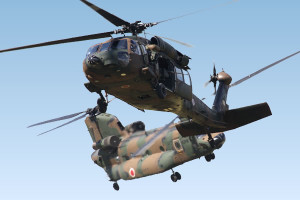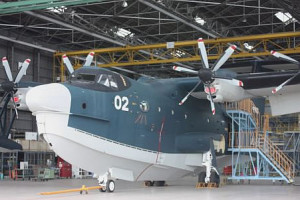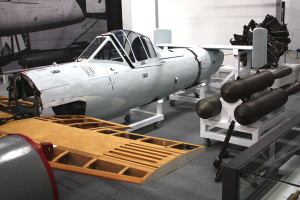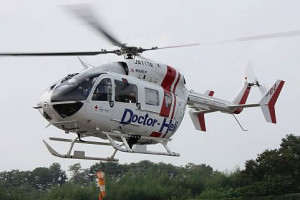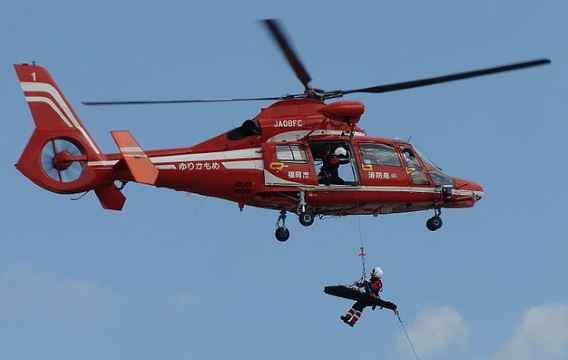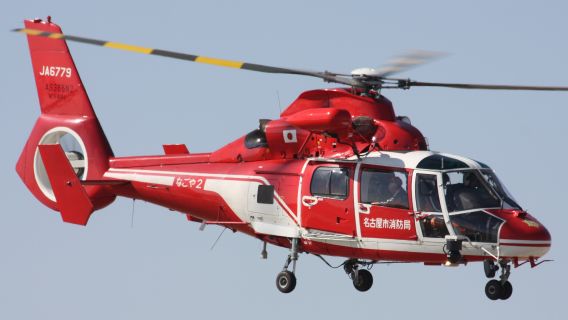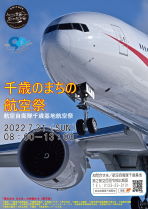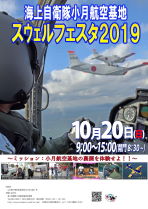Fire/Disaster Prevention
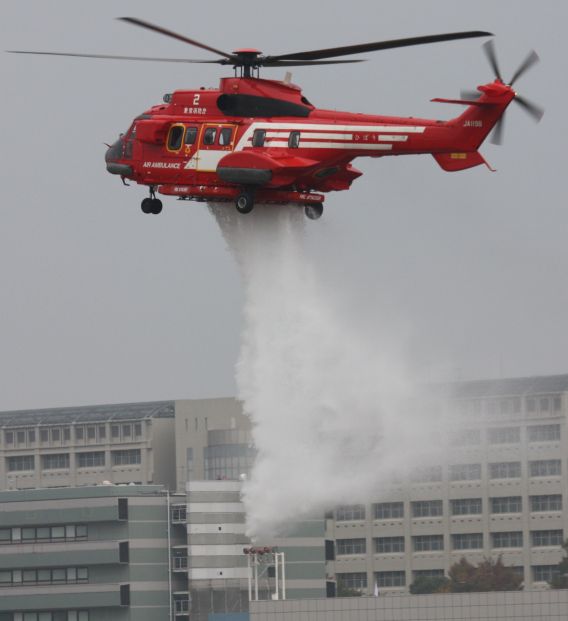 The crew of the Tokyo Fire Department’s fire attacker Eurocopter (Aérospatiale) AS332L1
The crew of the Tokyo Fire Department’s fire attacker Eurocopter (Aérospatiale) AS332L1
Super Puma JA119B demonstrates the aircraft’s capabilities at its Tachikawa, Tokyo, base
in November 2013. After nearly 20 years’ service, Hibari (Lark) 2 was retired early in 2020.
A nation that is particularly prone to natural disasters, Japan has aviation units in place that conduct the full gamut of emergency, firefighting and relief operations. Including that covering the capital, which comes under the jurisdiction of the Tokyo Fire and Disaster Management Agency, 16 cities and 39 of the country’s 47 prefectural administrations operate these dedicated, helicopter-equipped units. The 40th prefectural unit formed in Saga in April 2020, and its aircraft was being flight tested in August (see Bulletin Board page) with a view to becoming operational in March 2021.
Unlike the local fire department-controlled municipal units, which are independently operated, most prefectural governments prefer to outsource their aviation units’ operations to private company contractors. Maintaining a high degree of response readiness, units in the same region conduct regular joint training exercises that include the rehearsal and coordination of operations with Self-Defence Force elements.
J-HangarSpace will be winching itself down to delve into some fascinating aspects that will cover the aircraft, personnel, and operations of these units.
 A typical scene during coordinated disaster response operations. This is Hanamaki Airport,
A typical scene during coordinated disaster response operations. This is Hanamaki Airport,
Iwate Prefecture, on April 11, 2011, exactly a month after the Great East Japan Earthquake
triggered a tsunami that devastated large areas of the Tohoku region. Closest to the
camera is the Kobe City Air Corps’ then BK117B-2 KOBE-I, which is parked
alongside the Shizuoka Prefecture Air Rescue Team’s BK117C-1
Orange Arrow. Just starting up at the back is the AS332L1
Hakuchō 6 from the Tokyo Fire & Disaster Management
Agency (FDMA) Flying Unit. (Photo: 402SQC-1 via Wikimedia Commons)
In the meantime, as a temporary measure, tables listing the aircraft operated by each municipal or prefectural aviation unit have been added below. Interspersed with a growing number of photographs (indicated in bold type in the tables) and details of the aircraft markings, these will eventually serve as a separate Data File page.
In the case of the prefectural units, J-HangarSpace retains the name derived from the organisation under which each unit operates, officially known in English as a Disaster Prevention Bureau; it would be more accurate to refer to them as something like disaster relief aviation units. A unit’s unofficial English name, if any, appears after the formation date.
Please note that the in service date(s) for aircraft formerly operated are based on registration/cancellation data and are for guidance purposes only.

Operated by Honda Airways from Tochigi Heliport in Haga, Bell 412EP JA09TG Ooruri
(Blue-and-White Flycatcher) was in service with the Tochigi Prefectural Disaster
Prevention Aviation Unit for 20 years, from 1997 to 2017. Tochigi became
one of the 14 prefectures that have so far switched to an AW139.
 At the time still on Mitsui Bussan Aerospace’s books, AW139 JA06FD undergoes a ski-equipped
At the time still on Mitsui Bussan Aerospace’s books, AW139 JA06FD undergoes a ski-equipped
test flight at Yao Airport, Osaka, in March 2021. Its registered ownership was soon to be
changed to Kochi Air Rescue. (Photo: きりふだ via Twitter @KFD_613)
(All photographs on this website are copyright J-HangarSpace
unless otherwise stated.)
Municipal Fire Department Aviation Units
| Chiba Municipal Firefighting Aviation Unit | ||||
| Base | Chiba City Disaster Prevention Heliport, Chiba Prefecture | |||
| Date Formed | Apr. 1, 1992 (Fire Helicopter Corps) | |||
| Helicopter Type | Reg’n | c/n | Name |
In Service Date(s)/ First Deployment Date |
| AS365N2 | JA6687 | 6426 | Ootori 1 |
Jan. 1992 to Feb. 2006 |
|
AS365N3 |
JA119C | 6543 | Ootori 2 | Apr. 1, 1999 |
| JA03CF | 6722 | Ootori | Feb. 1, 2006 | |
| Last updated: July 24, 2013 | ||||
 Named Ootori after a legendary bird, Eurocopter (Aérospatiale) AS365N3 JA03CF has been
Named Ootori after a legendary bird, Eurocopter (Aérospatiale) AS365N3 JA03CF has been
operational with Chiba City’s Fire Helicopter Corps since February 2006.
 The two Chiba unit aircraft during one of their performances at the Red Bull Air Race meet that
The two Chiba unit aircraft during one of their performances at the Red Bull Air Race meet that
was held at Makuhari on the Chiba Prefecture coast in September 2019.
(Photo: なぎさ via Twitter @KatanoNagisa)
Initially, the Chiba unit’s tail marking comprised a series of what appeared to be six pale blue bubbles of increasing size that had arced up the tail of the first two aircraft (above). The city’s website refers to this design, which was devised in 1991, as its “communication mark”. The six discs are said to be representative of the city’s six wards and symbolize its people and resources, as well as the active flow and exchange of information that takes place within the city. This marking also symbolized Chiba City’s then new image as a growing centre for advanced information technology.
The first aircraft (the incredibly internet-shy JA6687 [link]) having already been retired by 2006, the two current aircraft received the Chiba City emblem (below) in the spring/summer of 2015. This 1921 design includes the moon and star coat of arms of the Chiba clan chief who founded what was to become the city after having adopted the name of the then district in feudal times. The emblem also contains a highly stylized (make that barely recognizable) version of the 千 (chi) of Chiba.
| Fukuoka Municipal Firefighting Aviation Unit | ||||
| Base | Fukuoka Airport, Fukuoka Prefecture | |||
| Date Formed | Apr. 1, 1975 (Fukuoka City Fire Prevention Bureau [FPB]) | |||
| Helicopter Type | Reg’n | c/n | Name |
In Service Date(s)/ First Deployment Date |
| SA.316B Alouette III | JA9136* | 2214 | Akatonbo |
Feb. 1975 to April 1996 |
| AS365N1 | JA9966 (link) | 6328 | Yurikamome |
Jan. 1990 to Feb. 2008 |
| AS365N2 | JA119F | 6500 | Hoojiro | Apr. 1, 1997 to Jan. 2018 |
| AS365N3 | JA08FC | 6790 | Yurikamome | Apr. 1, 2008 to (2023) |
| AS365N3+ | JA18AR | 7019 | Hoojiro | Feb. 1, 2018* |
| BK117D-3 | JA23DR | 21105 | Yurikamome | Oct. 9, 2023** |
| * See links to photos in text at end of this section. * Contract for AS365N3+ announced Oct. 13, 2016 for spring 2018 delivery ** ff (Gifu) Apr. 17, 2023, commissioning ceremony Oct. 2, 2023 |
||||
| Last updated: January 30, 2024 | ||||

A former and current helicopter in the service of the Fukuoka City FPB. (Above) AS365N2 Hoojiro
(Siberian Meadow Bunting), seen at Fukuoka Airport in December 2008, and (below)
AS365N3 Yurikamome (Black-headed Gull), at the same location in November 2012.
(Photos: Amayagan via Wikimedia Commons)
 Fukuoka City’s JA18AR on a visit to Kobe Airport in August 2021
Fukuoka City’s JA18AR on a visit to Kobe Airport in August 2021
(Photo: 飛龍 via Twitter @hiryu_uh60)
 (Photo: しだーぽむぽむ via Twitter @EPHSV)
(Photo: しだーぽむぽむ via Twitter @EPHSV)
Its order announced on June 30, 2021, BK117D-3 destined for Fukuoka City JA23DR was flown in primer early in October 2022 and registered the following month. Having made its first fully equipped flight on April 17, 2023, a cabin door was still unfinished a week later, when the photo above was taken at Gifu. The aircraft was in full livery and titling by the time of this photo (link), showing the aircraft departing Kounan Airport, Okayama Prefecture, for Nata Heliport in Fukuoka in June 2023.
Statistics released in June 2022 stated that the unit had been deployed within the city of Fukuoka on an average of 135 occasions a year over the three years from 2019 to 2021; wider area support missions during that period averaged 48.
Fukuoka’s long-serving initial equipment, the Alouette III Akatonbo (Dragonfly), was photographed in flight (link) and on the ground (link) at the Fukuoka Castle ruins in January 1991. After retirement, the aircraft was given pride of place at the Fukuoka Municipal Disaster Control Center, as seen in this photo from July 2012 (link).
| Hamamatsu Municipal Firefighting Aviation Unit | ||||
| Base | Hamamatsu Disaster Prevention Heliport, Shizuoka Prefecture | |||
| Date Formed | Apr. 1, 2009 (Air Rescue Team) | |||
| Helicopter Type | Reg’n | c/n | Name |
First Deployment Date |
| AS365N3 | JA119X | 6877 | Hamakaze | Dec. 16, 2009 |
| Last updated: July 9, 2013 | ||||
 After a fuel stop, Hamamatsu’s AS365N3 Hamakaze (Beach Wind) departs Shizuoka Heliport.
After a fuel stop, Hamamatsu’s AS365N3 Hamakaze (Beach Wind) departs Shizuoka Heliport.
(Photo [Sept. 2021]: カモノハツZ via Twitter @W1hUskaQUeaPe9Z)
 Hamakaze looks somewhat different on a bright, sunny day.
Hamakaze looks somewhat different on a bright, sunny day.
(Photo [Training at Fujikawa gliding field, Shizuoka City, Aug. 2020]: via Twitter @spci61-260)
The tail marking is the emblem that symbolizes the City of Hamamatsu. Adopted in 2005, the nature-inspired design consists of green upper and blue lower parts. The former represents the abundant forest in the north of the city, the latter the beauty of Lake Hamana and the Enshu Sea. The shape of the white Enshu Sea wave is said to express Hamamatsu’s dynamism and development.
| Hiroshima Municipal Firefighting Aviation Unit | ||||
| Base | Hiroshima-Nishi Airfield, Hiroshima Prefecture | |||
| Date Formed | Apr. 1, 1990 | |||
| Helicopter Type | Reg’n | c/n | Name |
In Service Date(s)/ First Deployment Date |
| AS365N1 | JA9978 (link) | 6336 | Hiroshima |
Feb. 1990 to July 2006 |
| AS365N3 | JA05HC | 6728 | Hiroshima | April 1, 2006 |
| Last updated: July 9, 2013 | ||||
 A photo taken during a training exercise designed to hone Hiroshima City aircrew skills in hoisting
A photo taken during a training exercise designed to hone Hiroshima City aircrew skills in hoisting
visually impaired people and their guide dogs to safety. The three wavy blue lines on the aircraft’s
tail are from Hiroshima’s official symbol, adopted from that of the former Aki (or Geishu)
province way back in 1896, as a three-river “City of Water”. In recent years, torrential
rainfall in the area has caused widespread flooding and landslides as well as loss
of life, so the unit has to maintain a high level of readiness.
(Photo [August 2020]: Hiroshima Fire Service Bureau via Twitter @Hiroshima F_S_B)
| Kawasaki Municipal Firefighting Aviation Unit (Kanagawa Prefecture) | ||||
| Base | Tokyo Heliport | |||
| Date Formed | July 1, 1985 (Kawasaki Air Rescue) | |||
| Helicopter Type | Reg’n | c/n | Name |
In Service Date(s)/ First Deployment Date |
| BK117B-2 | JA9620 (link) | 1011 | Soyokaze 1 |
May 1985 to May 2005 |
| BK117B-2 | JA6730 (link) | 1098 | Soyokaze 2 | Apr. 1, 1994 |
| BK117C-2 | JA01KF | 4008 | Soyokaze 1 | Apr. 1, 2005 |
| AS365N3+ | JA02KF | 6999 | Soyokaze 2 | (See Note) |
| Note: Signed contract with Airbus Helicopters Japan for AS365N3+ April 30, 2014. Test flown at Kobe mid-July 2015 | ||||
| Last updated: Nov. 19, 2015 | ||||
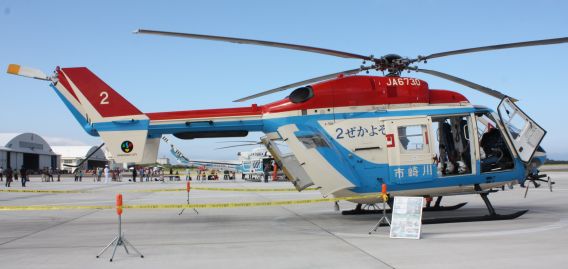 Then named Soyokaze (Zephyr) 2, the Kawasaki Air Rescue MBB/Kawasaki BK117B-2 was on
Then named Soyokaze (Zephyr) 2, the Kawasaki Air Rescue MBB/Kawasaki BK117B-2 was on
static display at JMSDF Tateyama, Chiba Prefecture, October 6, 2013. This aircraft was
renamed Soyokaze 1 when supplanted by the brand-new AS365N3+ in 2015.
 Kawasaki representative JA01KF sets the dust swirling when landing at a sports park in Isehara,
Kawasaki representative JA01KF sets the dust swirling when landing at a sports park in Isehara,
Kanagawa Prefecture, the focal point of a joint mountain rescue training exercise in
September 2019. This aircraft has been in service since April 2005.
(Photo: なぎさ via Twitter @KatanoNagisa)
 From the time of its introduction in July 2015 to the summer of 2018, JA02KF carried a promotional
From the time of its introduction in July 2015 to the summer of 2018, JA02KF carried a promotional
marking (below) portraying facets of Kawasaki on both stabilizer end-plates. Also carried on some
of the city’s buses, the elements indicated the city’s greenery (not apparent in the above, seemingly
colour-saturated image), clean water, passion for art, and warm-hearted people.
(Photo [2018]: WEASEL via Twitter @遺伝子組換え済)
 As seen in the opening photo, this promotional marking was also carried by JA6730,
As seen in the opening photo, this promotional marking was also carried by JA6730,
from 2007 to 2015. (Image: はちあまやか via Twitter @mayakamakiri)
 Sorokaze 2 taxying at Tokyo Heliport in February 2016. Based on the river kanji 川 (kawa)
Sorokaze 2 taxying at Tokyo Heliport in February 2016. Based on the river kanji 川 (kawa)
of Kawasaki and black in its original form, the blue Kawasaki City symbol carried on
the nose and fuselage sides dates all the way back to 1925.
(Photo: ‘Mr.Minazuki’ via Wikimedia Commons)
 A beautifully lit photo of Soyokaze 2 taken at Shiroyama Lake in Sagamihara, Kanagawa Prefecture,
A beautifully lit photo of Soyokaze 2 taken at Shiroyama Lake in Sagamihara, Kanagawa Prefecture,
during a forest firefighting training exercise held in September 2020.
(Photo: Red pepper via Twitter @ichikyk119)
| Kita-Kyushu Municipal Firefighting Aviation Unit | ||||
| Base | Kita-Kyushu Airport, Fukuoka Prefecture | |||
| Date Formed | May 14, 1993 (Kita-Kyushu Fire Aviation Corps) | |||
| Helicopter Type | Reg’n | c/n | Name |
In Service Date(s)/ First Deployment Date |
| AS365N2 | JA6701 (link) | 6473 | Kitakyuu |
1993–2010 |
| AS365N3 | JA10KC | 6903 | Kitakyuu | Apr. 12, 2010 |
| Last updated: July 9, 2013 | ||||
 (Above) The second AS365 to be named Kitakyuu and operated by the Kita-Kyushu unit rests in its
(Above) The second AS365 to be named Kitakyuu and operated by the Kita-Kyushu unit rests in its
hangar at Kita-Kyushu Airport in March 2016. (Below) The speaker array mounted on the rear
fuselage is primarily used to communicate with those in need of assistance.
 (Photos: ぽっちー via Twitter @pochi_m)
(Photos: ぽっちー via Twitter @pochi_m)
A short, high-quality YouTube video of this aircraft in action, taking off and departing after a training exercise in June 2010, can be found here (link). On the markings front, note that the rakish blue fuselage stripe carries the words Kitakyushu City Fire and Disaster Management Department (link). The tail marking (link) is of the city’s “herb” design, the surrounding five petals of which represent the five then municipalities that were merged to form the city in 1963. The center design is primarily a stylized 北 (kita, meaning north), while the star-shaped design denotes industry in the form of a gear and the radial urban development of the city.
| Kobe Municipal Firefighting Aviation Unit | ||||
| Base | Kobe Heliport, Hyogo Prefecture | |||
| Date Formed | Jan. 1972 (Kobe City Air Corps) | |||
| Helicopter Type | Reg’n | c/n | Name |
In Service Date(s)/ First Deployment Date |
| Hughes 369HS | JA9069* | 6619 |
Oct. 1971 to Mar. 1988 |
|
| Bö105S | JA9556 (link) | S-435 |
Jan. 1981 to Nov. 2003 |
|
| BK117 |
JA9608 |
1006
|
KOBE-II ? |
July 1984 to July 1990 |
| BK117A-4 | KOBE-II ? |
July 1990 to Sept. 1995 |
||
| BK117B-2 | KOBE-III |
Sept. 1995 to Nov. 2007 |
||
| BK117B-2 | JA6739 (link) | 1099 | KOBE-I | Dec. 1994 to (2015) |
|
|
JA28HY* | 4009 | Mar. 2006 | |
| JA02KB | 4010 | KOBE-II | Mar. 2007 | |
| JA01HK | 4034 | HYOGO/KOBE-I | Flight tested at Gifu, Sept. 2014** | |
| * See links to photos in text at end of section. * JA28HY entrusted to Kobe from Hyogo Prefectural Disaster Prevention Aviation Unit ** Order announced by KHI Oct. 15, 2013, del. Jan. 21, 2015 |
||||
| Last updated: Oct. 9, 2021 | ||||
 The Kobe City Air Corps’ BK117C-2 KOBE-II passes over the city’s Port Island in September 2008.
The Kobe City Air Corps’ BK117C-2 KOBE-II passes over the city’s Port Island in September 2008.
The Air Corps is attached to the Keibōtai (literally Civilian Guard Unit) of the city’s Fire
Department and operates its helicopters jointly with the Hyogo Prefectural Disaster
Prevention Aviation Unit. (Photo: “J o” via Wikimedia Commons)
 (Above) The most recent addition to the Hyogo-Kobe fleet JA01HK over the Kobe cityscape in
(Above) The most recent addition to the Hyogo-Kobe fleet JA01HK over the Kobe cityscape in
January 2020. Along the base of its white bird fuselage marking (below), the aircraft carries
the blue flag symbol for Hyogo Prefecture (described in the Hyogo Prefecture entry) and
that in green of Kobe City alongside their names in Japanese.
 (Photos: M via Twitter @Ssssa002)
(Photos: M via Twitter @Ssssa002)
The Kobe City flag emblem depicts two fans, which the Port of Kobe (formerly Hyogo Port) is said to resemble. For flag purposes appearing in white on a green background, as seen above the symbol appears on the sides of the aircraft in green on JA01HK and in white on JA02KB, the latter carrying the green version above the word KOBE under its nose (link, and in lead photo).
 HYOGO・KOBE-I during its spirited performance at the traditional New Year firefighters’ festival
HYOGO・KOBE-I during its spirited performance at the traditional New Year firefighters’ festival
at Kobe Port, January 2020 (Photo: M via Twitter @Ssssa002)
 Going a little further back in time, BK117B-2 JA6739 served as KOBE-I until 2015 and
Going a little further back in time, BK117B-2 JA6739 served as KOBE-I until 2015 and
was eventually passed on to a new owner in New Zealand.
(Photo: seasons via Twitter @Seasons4100)
The first helicopter to serve Kobe, the Hughes 369 JA9069, was noted at the city’s disaster relief centre heliport in July 1981 (link). The aircraft was still on display at the facility now called the Bando Kobe Youth Science Museum in October 2020 (link).
| Kyoto Municipal Firefighting Aviation Unit | ||||
| Base | Kyoto Disaster Prevention Heliport, Kyoto Prefecture | |||
| Date Formed | Apr. 1, 1972 | |||
| Helicopter Type | Reg’n | c/n | Name |
In Service Date(s)/ First Deployment Date |
| SA.316B Alouette III | JA9072* | 1887 | Kyoto |
Mar. 1972 to June 1992 |
| SA365N1 Dauphin 2 | JA9673* | 6290 | Hiei |
Jan. 1998 to Aug. 2005 |
| AS365N2 | JA6688 (link) | 6428 | Atago |
Jan. 1992** |
|
AS365N3 |
JA911A | 6671 | Hiei | Apr. 2005 |
| JA02FD | 6924 | Atago | Aug. 2011 | |
| * See links to photos in text at end of this section. ** JA6688 eventually leased to Miyagi Prefectural DPAU Oct. 1, 2012 to July 31, 2013 |
||||
| Last updated: Oct. 4, 2013 | ||||
 Painted on the undersides of JA911A are the kyō from Kyoto and shō from shōbō (fire department).
Painted on the undersides of JA911A are the kyō from Kyoto and shō from shōbō (fire department).
(Photo [Dec. 2019]: インコ好き via Twitter @color_hiyoko)
 Named after a mountain located within Kyoto’s city limits, AS365N3 Atago departs
Named after a mountain located within Kyoto’s city limits, AS365N3 Atago departs
Kobe Airport in August 2021. (Photo: 飛龍 via Twitter @hiryu_uh60)
 (Above [JA911A] and below [JA02FD]) The two gleaming Kyoto AS365N3 helicopters in their
(Above [JA911A] and below [JA02FD]) The two gleaming Kyoto AS365N3 helicopters in their
hangar at the city’s heliport, December 2018
 (Photos: 祥 via Twitter @rescue60K)
(Photos: 祥 via Twitter @rescue60K)
Kyoto’s first two helicopters, the Alouette III JA9072 (link) and the Dauphin 2 JA9673 then named Kyoto 2 (link), were photographed at Osaka-Itami Airport in June 1980 and March 1988, respectively. The former was placed on display at Kyoto City Disaster Prevention Center until replaced by JA9673 in August 2005.
| Nagoya Municipal Firefighting Aviation Unit | ||||
| Base | Nagoya Airport, Aichi Prefecture | |||
| Date Formed | Apr. 1, 1973 (Air Rescue Nagoya) | |||
| Helicopter Type | Reg’n | c/n | Name |
In Service Date(s)/ First Deployment Date |
| SA.316B Alouette III | JA9093* | 1988 | Nagoya |
Feb. 1973 to Sept. 1991 |
| SA365C1 Dauphin 2 | JA9557 (link) | 5044 | Nagoya 2 |
Feb. 1981 to July 1996** |
| AS365N1 | JA9693 (link) | 6304 | Nagoya |
Apr. 1988 to July 2007 |
| AS365N2 | JA6779 (link) | 6496 | Nagoya 2 | Mar. 29, 1996 to 2015 |
| AS365N3 | JA758A | 6758 | Nagoya → Nobunaga |
Mar. 16, 2007 Renamed Sept. 2014 |
| AS365N3+ | JA08AR | 7001 | Hideyoshi | Apr. 1, 2015* |
| * See links to photos in text at end of this section. ** JA9557 on display at the Nagoya Municipal Minato Disaster Prevention Center * JA08AR registered Oct. 27, 2014 and commissioned Mar. 20, 2015 |
||||
| Last updated: Nov. 19, 2015 | ||||

(Above) Former Nagoya Municipal Firefighting Aviation Unit Alouette III JA9093 was placed on
display at the then Kakamigahara Aerospace and Science Museum, Gifu Prefecture, in March
1996. Seen here in October 2000, the aircraft was eventually passed on to The Association
for the Preservation of Helicopter History in July 2016. Its successor was AS365N2
Nagoya 2 (below), which was itself replaced by ‘N3 Hideyoshi in 2015.
 The two latest generation aircraft currently operated in flight over the city (above) with
The two latest generation aircraft currently operated in flight over the city (above) with
Nagoya Castle in the background and (below) during a display at the traditional
New Year firefighters’ event event held at the Port of Nagoya, January 2020.
 (Photos: [Top] City of Nagoya Fire Department via Twitter @NagoyaShobo);
(Photos: [Top] City of Nagoya Fire Department via Twitter @NagoyaShobo);
[above] しだーぱむぱむ® ver.2.01 via Twitter @EPSHV)
In the linked images, that first aircraft to bear the name Nagoya, the Alouette III JA9093, is seen at JGSDF Akeno in October 1976 (link) and Osaka-Itami Airport in August 1983 (link).
| Okayama Municipal Firefighting Aviation Unit | ||||
| Base | Konan Airport, Okayama Prefecture | |||
| Date Formed |
Apr. 1, 1997 (Fire Defence & Prevention Div., Aviation Control Office / Okayama Fire Avaition Corprs) |
|||
| Helicopter Type | Reg’n | c/n | Name |
First Deployment Date |
| BK117C-1 | JA6793 (link) | 1108 | Momotarou | Nov. 28, 1996 |
| BK117C-2 | JA33BK | 4035 | Momotarou | [See Note] |
| Replacement BK117C-2 order announced Jan. 22, 2014, delivery announced Mar. 27, 2015 | ||||
| Last updated: Jan. 30, 2022 | ||||
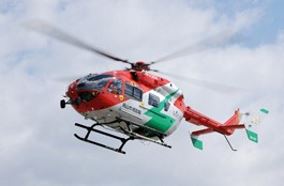 Okayama Air Rescue’s BK117C-2 replaced an earlier model ‘C-1 in 2015. (Photo: KHI)
Okayama Air Rescue’s BK117C-2 replaced an earlier model ‘C-1 in 2015. (Photo: KHI)
 A somewhat clearer image of JA33BK, which is named Momotarō (Peach Boy) after the legend that
A somewhat clearer image of JA33BK, which is named Momotarō (Peach Boy) after the legend that
is said to have taken place in Okayama; hence the peaches as a tail marking. The aircraft is based
at Okayama Momotaro Airport. (Photo [taken in 2020]: ひょーご via Twitter @0128BKHY)
The above poster spotlights the main operations of the Okayama Fire Aviation Corps (not to be confused with the prefectural-level Air Rescue Team q.v.). The Japanese at the top reads:
Doing their utmost to protect and preserve lives.
The disaster prevention helicopter Momotarō crew members protect the lives, physical well-being and property of Okayama’s citizens.
(Left-hand photo column, top to bottom): Clear for takeoff! / Attaching a fire bucket / Patient/casualty airlift / Maintenance / Images relayed from on-board TV camera; (Right-hand photo column): Winter mountain rescue / Firefighting activities / At the scene of a fire / Flood rescue / Cockpit
In 2020, the latest full year for which statistics are available, the helicopter was sent on a total of 75 missions: 28 fires, 32 emergency cases, 14 rescues, and one other of an unspecified nature.
In 2021, the unit reached the milestone of 7,000 accident-free flying hours. A short PR video (best with the sound off) can be viewed on YouTube here (link).
| Osaka Municipal Firefighting Aviation Unit | ||||
| Base | Yao Airport, Osaka Prefecture | |||
| Date Formed | Apr. 1, 1970 | |||
| Helicopter Type | Reg’n | c/n | Name |
In Service Date(s)/ First Deployment Date |
| Hughes 369S | JA9040* | 1090207S | Oosaka |
Mar. 1977 to July 1988 |
| SA.316B Alouette III | JA9146* | 2251 | Oosaka 2 |
Jan. 1976 to June 1993 |
| SA365N Dauphin 2 | JA9649 (link) | 6218 | Oosaka |
Dec. 1986 to Jul. 2005 |
| AS365N2 | JA6700 (link) | 6438 | Naniwa |
Feb. 1993 to July 2010 |
|
AS365N3 |
JA050F | 6695 | Oosaka | April 1, 2005 |
| JA100F | 6897 | Naniwa | April 1, 2010 | |
|
H155 |
JA210F | 7052 | Oosaka | Dec. 2020 |
| * See links to photos in text at end of this section. Note: Airbus Helicopters announced order for H155 (to replace JA050F) Oct. 23, 2019. |
||||
| Last updated: Sept. 17, 2021 | ||||
 After a 16-year career, Osaka Fire Department’s JA050F was on the verge of
After a 16-year career, Osaka Fire Department’s JA050F was on the verge of
replacement by the H155 when this photo was taken in June 2021.
(Photo: ひょーご via Twitter @0128BKHY)
 AS365N2 JA100F carries the hiragana for Naniwa, Osaka’s original name and now that of one of
AS365N2 JA100F carries the hiragana for Naniwa, Osaka’s original name and now that of one of
its administrative wards. (Photo [posted June 2021]: n_あゝあ via Twitter AaaNisimine)
 Osaka’s new H155 at Yao a few days before its official commissioning ceremony, which was held on
Osaka’s new H155 at Yao a few days before its official commissioning ceremony, which was held on
September 1, 2021. (Photo: ヒロ via Twitter @HiroRjoy)
Following Kobe’s lead but six years later, a Hughes 369 was acquired as the first Oosaka in 1977. The aircraft is seen here (link) at Yao in November 1980. Like the BK117s and AW139s of today, the Alouette III cornered a fair share of the Japanese market in the 1970s; JA9146 was photographed, also at Yao, in May 1978 (link).
| Sapporo Municipal Firefighting Aviation Unit | ||||
| Base | Ishikari Heliport, Hokkaido Prefecture | |||
| Date Formed | Mar. 1, 1991 (Sapporo Air Rescue) | |||
| Helicopter Type | Reg’n | c/n | Name |
First Deployment Date |
| Bell 412 | JA6636 | 36008 | Sapporo 2 | March 1, 1991 |
| Bell 412EP | JA119L* | 36462 | Sapporo 1 | April 1, 2009 |
| AW139** | JA17AR | 41519 | Sapporo 2 | ex-N592SH |
| * Bell 412EP delivered as N6317X ** AW139 first registered to Mitsui Bussan Aerospace Aug. 2016, fitted out at Toyo Aviation, Chofu Airport from Oct. and test flown Jan./Feb. 2017 |
||||
| Last updated: Mar. 1, 2017 | ||||
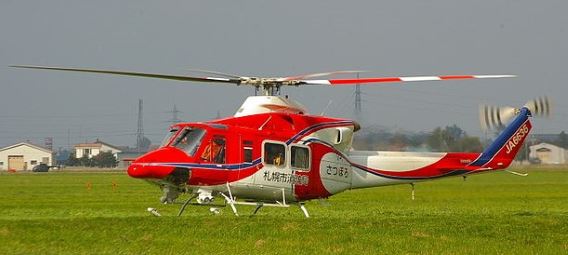 Sapporo Air Rescue’s Bell 412 JA6636, the previous Sapporo 2, seen at Okadama airport, Hokkaido,
Sapporo Air Rescue’s Bell 412 JA6636, the previous Sapporo 2, seen at Okadama airport, Hokkaido,
in October 2007. (Photo: “100yen” via Wikimedia Commons)
 Bell 412EP JA119L (Photo [Okadama Airport, Sept. 2009]: CJ via Twitter @armingarea1836)
Bell 412EP JA119L (Photo [Okadama Airport, Sept. 2009]: CJ via Twitter @armingarea1836)
 The Sapporo fleet’s capabilities were greatly enhanced by the arrival of its AW139, which was built
The Sapporo fleet’s capabilities were greatly enhanced by the arrival of its AW139, which was built
at AgustaWestland’s Philadelphia facility in 2016. (Photo: たかぽん via Twitter @takapochen)
When the weather conditions demand, the aircraft is fitted with skis (link).
| Sendai Municipal Firefighting Aviation Unit | ||||
| Base | Sendai Airport, Miyagi Prefecture | |||
| Date Formed | Apr. 1, 1993 (Sendai Fire Aviation) | |||
| Helicopter Type | Reg’n | c/n | Name |
In Service Date(s)/ First Deployment Date |
| BK117B-1 |
JA6698* |
1103 |
Sendai |
Oct. 1992 to Sept. 1993 |
| BK117B-2 |
Sept. 1993 to Sept. 2011 |
|||
|
Bell 412EP |
JA119T | 36372 | Keyaki | Nov. 2005 |
| JA119J | 36538 | Sendai | Mar. 2011 | |
| * JA6698 See links to photos in text at end of this section. | ||||
| Last updated: July 24, 2013 | ||||
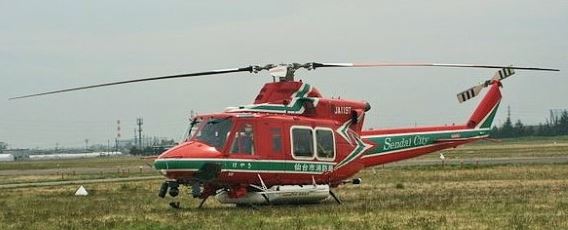 One of the two Bell 412EPs operated by the Sendai Municipal Firefighting Aviation Unit, JA119T
One of the two Bell 412EPs operated by the Sendai Municipal Firefighting Aviation Unit, JA119T
is named Keyaki (Zelkova) after the tree chosen to symbolize Miyagi Prefecture.
(Photo [April 2015]: Ebiebi2 via Wikimedia Commons)
 In April 2019, the other 412EP Sendai was a visitor to JGSDF Kasuminome for the 62nd
In April 2019, the other 412EP Sendai was a visitor to JGSDF Kasuminome for the 62nd
anniversary of the garrison’s establishment. (Photo: 北狸 via Twitter @Kitadanuki)
Sendai’s BK117 visited Ichinoseki, Iwate Prefecture, in October 2007 (link) and was present with JA119T at the central park in Kakuda, Miyagi Prefecture, in April 2009 (link). Damaged at Sendai Airport in the tsunami of March 11, 2011, its registration was cancelled in September of that year.
| Shizuoka Municipal Firefighting Aviation Unit | ||||
| Base | Shizuoka Heliport, Shizuoka Prefecture | |||
| Date Formed | Apr. 1, 2008* (Shizuoka City Fire Bureau Air Rescue) | |||
| Helicopter Type | Reg’n | c/n | Name |
First Deployment Date |
| Bell 412EP | JA119P | 36439 | Kawasemi | Mar. 28, 2008 |
| * Started operations Oct. 1, 2008 | ||||
| Last updated: July 24, 2013 | ||||
 Along with Hiroshima and Okayama, Shizuoka is one of the three prefectures that operate units at
Along with Hiroshima and Okayama, Shizuoka is one of the three prefectures that operate units at
the prefectural level and from a city of the same name. This photo was taken during an event
at Shizuoka heliport where members of the public could experience being winched up to the
aircraft and flown around the airfield. (Photo [Oct. 2018]: あっき via Twitter @donguri_ka)
 The helicopter named Kawasemi (Kingfisher) during a training exercise at Shizuoka heliport.
The helicopter named Kawasemi (Kingfisher) during a training exercise at Shizuoka heliport.
The emblem carried on the nose of the aircraft (below) depicts three “kawasemi-zu”
rushing to answer a 119 emergency call.
(Photo [Oct. 2018]: カリス(支援舟に心を奪われた者) via Twitter @TeamCaris) (Image: Shizuoka City Fire Bureau Facebook)
(Image: Shizuoka City Fire Bureau Facebook)
Adopted in 2003, the redesigned Shizuoka City flag that forms the tail marking (link) combines the image of a white Mt. Fuji with the waves of Suruga Bay in the shape of an S.
| Tokyo Fire & Disaster Management Agency Flying Unit (Part 1/2) | ||||
| Base | Tokyo Heliport and JGSDF Tachikawa, Tokyo | |||
| Date Formed | Nov. 1, 1966 | |||
| Helicopter Type | Reg’n | c/n | Name |
In Service Dates |
|
SE.3160 Alouette III |
JA9020* | 1376 | Chidori |
Mar. 1967 to Feb. 1983 |
| JA9027 | 1516 |
Jan. 1969 to Dec. 1985 |
||
|
SA.316A Alouette III |
JA9071 (link) | 1877 | Kamome |
Mar. 1972 to Aug. 1988* |
| JA9121 (link) | 2000 | Mizutama |
May 1974 to Nov. 1990 |
|
|
SA365N Dauphin 2 |
JA9569 (link) | 6029 | Chidori |
Mar. 1982 to June 1997* |
| JA9610 (link) | 6138 | Hibari 2 |
Jan. 1985 to June 2001 |
|
|
AS365N1 |
JA9692 (link) | 6305 | Kamome 3 |
May 1988 to Aug. 2009 |
| JA9980 (link) | 6334 | Tsubame 5 |
Feb. 1990 to Sept. 2010 |
|
| AS365N2 | JA119A (link) | 6508 | Chidori 1 |
Mar. 28, 1997** |
| SA330F Puma | JA9512 | 1141 | Yurikamome |
Nov. 1972 to Aug. 1988*** |
|
AS332L1 |
JA6720 (link) | 2397 | Hakuchou 6 |
Mar. 14, 1994+ |
| JA9676 | 2201 | Yurikamome 4 |
Jan. 1988 to Nov. 2008 |
|
| JA119B | 2540 | Hibari 2 |
June 9, 2001 to 2020 |
|
|
* See links to photos in text below. |
||||
| Last updated: Oct. 10, 2021 | ||||
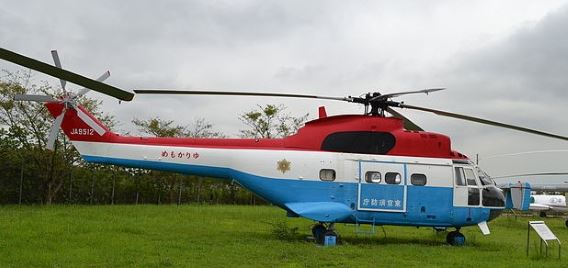 Formerly operated from Tokyo heliport, this SA330F was put out to grass at the Museum of
Formerly operated from Tokyo heliport, this SA330F was put out to grass at the Museum of
Aeronautical Sciences in August 1989. (Photo [Sept. 2013]: Alec Wilson via Wikimedia Commons)
The same aircraft during its service career, at Sunpu Castle Park in
Shizuoka City, September 1984 (link).
 Named Yurikamome (Black-Headed Gull), Eurocopter (Aérospatiale) AS332L-1 Super Puma
Named Yurikamome (Black-Headed Gull), Eurocopter (Aérospatiale) AS332L-1 Super Puma
JA9676 sported twin nose-mounted hoses for tackling fires in high-rise buildings when
operated by the Tokyo Fire Department Aviation Unit. After 20 years’ service,
this aircraft was replaced by an EC225LP in 2008.
In the year after its entry into service, Alouette III JA9020 Chidori (Plover) was present at the major event Iruma air show in October 1968 (link). This aircraft was eventually placed on display at the Tokyo Fire Museum, which was visited by J-HangarSpace in September 2013 (link). The aircraft was still present in January 2019 (link), by which time the conditions for photography had been improved.
| Tokyo Fire & Disaster Management Agency Flying Unit (Part 2/2) | ||||
| Helicopter Type | Reg’n | c/n | Name |
In Service Date(s)/ First Deployment Date |
EC225LP |
JA119Y | 2678 | Yurikamome 4 | Mar. 27, 2008 |
| JA71KT | 2885 | Kounotori 7 | Delivered Sept. 2013 | |
| JA62HC | 2901 | Hakuchou 6 | Arr. Kobe Mar. 3, 2014 | |
|
AW139 |
JA05FD | 41324 | (See Note*) | |
| JA14TD | 41518 | Chidori 1 | (See Note**) | |
|
AS365N3 |
JA01FD | 6691 | Ootaka | Dec. 22, 2005 |
| JA119E | 6839 | Kamome 3 | Mar. 27, 2009 | |
| JA119G | 6893 | Tsubame 5 | Mar. 25, 2010 | |
| AW189*** | JA24HB | 89012 | Hibari 2 | (At Nagoya, June 2019) |
|
* Initially reg’d to Mitsui Bussan May 2013, to Tokyo FDMA Aug. 2013 *** Order announced Oct. 16, 2017 |
||||
| Last updated: Oct. 10, 2021 | ||||
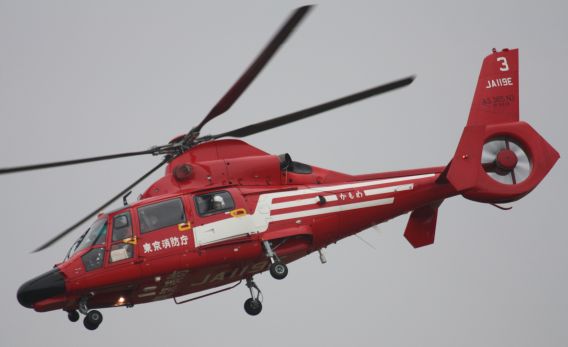
(Above and below) Taken at Tachikawa in November 2013, these two views are of JA119E
Kamome (Seagull), one of the three Eurocopter (Aérospatiale) AS365N3s operated by the
Tokyo Fire Department.
 AW139 JA14TD Chidori 1, one of the new guard now operating with the Tokyo service.
AW139 JA14TD Chidori 1, one of the new guard now operating with the Tokyo service.
(Photo: さくらもち (Sakuramochi) via Twitter @Zpp4O7)
 EC225LP JA71KT Konoutori (White Stork) at Tokyo Heliport in January 2019
EC225LP JA71KT Konoutori (White Stork) at Tokyo Heliport in January 2019
(Photo: QB-TCY via Twitter @zapper119)
 (Above and below) The first of its type in Japan and then the newest addition to the Tokyo fleet,
(Above and below) The first of its type in Japan and then the newest addition to the Tokyo fleet,
AW189 JA24HB commenced operations after a four-month crew training period in July 2020.
 (Photos [Tokyo Heliport]: [Top, Aug. 2020] Waka via Twitter @cygnus_001;
(Photos [Tokyo Heliport]: [Top, Aug. 2020] Waka via Twitter @cygnus_001;
[above, June 2020] なぎさ via Twitter @KatanoNagisa)
| Yokohama Municipal Firefighting Aviation Unit | ||||
| Base | Yokohama Heliport, Kanagawa Prefecture | |||
| Date Formed | Apr. 1, 1980 | |||
| Helicopter Type | Reg’n | c/n | Name |
In Service Date(s)/ First Deployment Date |
| SA365C1 Dauphin 2 | JA9544 (link) | 5064 |
Feb. 1980 to July 1995 |
|
| AS365N | JA9585 (link) | 6069 |
Feb. 1983 to July 1998 |
|
| AS365N2 | JA6740* (link) | 6477 | Hamachidori 1 |
Mar. 1995 to ? |
| AS365N2 | JA98YH** (link) | 6528 | Hamachidori 2 | Apr. 1, 1998 |
|
AW139 |
JA131Y | 41315 | Hamachidori 1 | Apr. 1, 2013 |
| JA152Y* | 41385 | Hamachidori 2 | ||
| * Formerly G-BYUR; ** N6400J; * Test flown at FHI Utsunomiya late Feb. 2015 to replace JA6740 | ||||
| Last updated: Apr. 5, 2018 | ||||
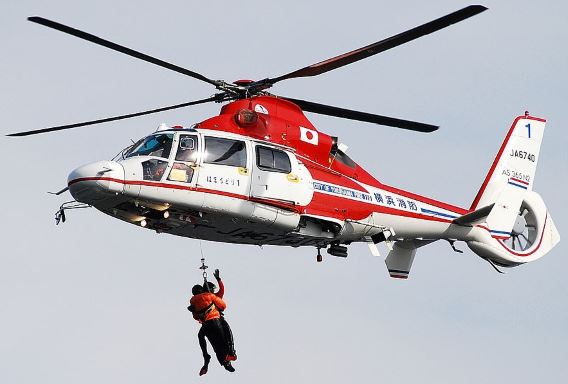 Yokohama heliport-based AS365N2 Hamachidori 1 (Plover 1) seen giving an air rescue
Yokohama heliport-based AS365N2 Hamachidori 1 (Plover 1) seen giving an air rescue
demonstration during the Yokohama Fire Department’s New Year Parade
in January 2013. (Photo: Toshinori Baba via Wikimedia Commons)
 Another fine action shot, this time of old guard sister aircraft AS365N2 Hamachidori 2
Another fine action shot, this time of old guard sister aircraft AS365N2 Hamachidori 2
in August 2014 (Photo: Mj-bird via Wikimedia Commons)
 The first of the Yokohama AW139s bows to the crowd (above) and leaves the stage at the 2014
The first of the Yokohama AW139s bows to the crowd (above) and leaves the stage at the 2014
edition of the city’s New Year fire department festival. Maintaining the tradition, both
aircraft have have retained the name of their predecessors, Hamachidori (Plover). (Photos: ‘shampoorobot’ via Wikimedia Commons)
(Photos: ‘shampoorobot’ via Wikimedia Commons)
 (Photo: Chiba Fire Helicopter Corps via Twitter @chiba_shobo)
(Photo: Chiba Fire Helicopter Corps via Twitter @chiba_shobo)
Prefectural Disaster Prevention Bureau Aviation Units
| Aichi Prefectural Disaster Prevention Aviation Unit | ||||
| Operator | Nakanihon Air Service Co., Ltd. | |||
| Base | Nagoya Airfield | |||
| Date Formed | Apr. 1, 1996 | |||
| Helicopter Type | Reg’n | c/n | Name |
First Deployment Date |
| Bell 412EP | JA6792 | 36117 | Wakashachi | Oct. 1, 1996* |
| Bell 412EPI** | JA23AR | 37013 | Wakashachi | c. July 2017 |
|
* Aircraft first registered June 1996 (ex N92115), reg’n cancelled and sold in Australia Apr. 2018 |
||||
| Last updated: Nov. 9, 2018 | ||||
 Aichi Prefecture’s Bell 421EP (above) was replaced by a 412EPI in the same colour scheme.
Aichi Prefecture’s Bell 421EP (above) was replaced by a 412EPI in the same colour scheme.
(Photo: CHIYODA I [Sept. 2015] via Wikimedia Commons)
 An Aichi Air Rescue crew puts on a demonstration for visitors to the Aichi Museum of Flight in
An Aichi Air Rescue crew puts on a demonstration for visitors to the Aichi Museum of Flight in
October 2019. The aircraft is named Wakashachi (Young Shachi),shachi being the half carp,
half tiger creature of Japanese folklore believed to guard against fire, as found decorating
the roof of Nagoya Castle in Aichi. In modern Japanese shachi means orca.
(Photo: てっちゃん@aichi_mof_vol via Twitter @ae01152751)
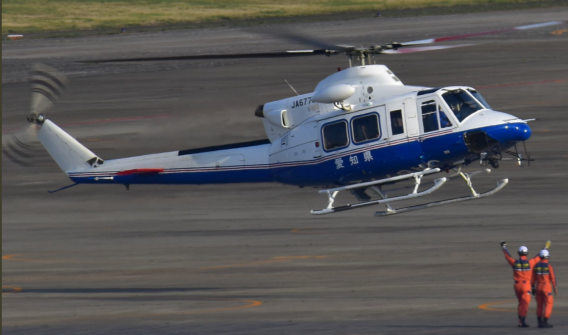 (Above and below) Carrying the Japanese for Aichi Prefecture on the sides of its fuselage, veteran
(Above and below) Carrying the Japanese for Aichi Prefecture on the sides of its fuselage, veteran
stand-in Bell 412EP JA6772 departs Nagoya Airport in May 2020. From 1996 to 2016, this
aircraft was operated by Hokkaido Police before being acquired in 2017 by a company
called TMC International. Short-term leases covering helicopter overhaul absences
had previously seen the aircraft bearing titling for Gunma (2017), Wakayama (2018),
Kagoshima and Iwate (2019) prefectures. The aircraft had returned to Hokkaido by
June 2020, this time for service with the Sapporo municipal aviation unit, and
was still present there in July 2021.
 (Photos: サ via Twitter @HgoNkm)
(Photos: サ via Twitter @HgoNkm)
 Rescue personnel salute at the end of a demonstration flight in February 2016. Likewise in
Rescue personnel salute at the end of a demonstration flight in February 2016. Likewise in
temporary service with Aichi Air Rescue at the time, Bell 412 JA6767 has also seen stand-in
service with Mie Prefecture (q.v.). (Photo: 豊川救工41 via Twitter @rescue510708)
 Not surprisingly, many helicopters in full-time operation with these units carry their
Not surprisingly, many helicopters in full-time operation with these units carry their
respective prefectural flags as identifying markings. The Aichi Prefecture design,
which dates back to 1950 and is normally white on a red background, depicts
a stylized あいち (Aichi) in the form of whitecaps on the Pacific Ocean.
(Image: Nameneko via Wikimedia Commons)
| Akita Prefectural Disaster Prevention Aviation Unit | ||||
| Operator | (Independently operated*) | |||
| Base | Akita Airport | |||
| Date Formed | Apr. 1, 1999 (Akita Air Rescue) | |||
| Helicopter Type | Reg’n | c/n | Name |
First Deployment Date |
| BK117C-1 | JA6848 | 1123 | Namahage | Mar. 30, 1999 |
| BK117C-2** | JA05AR | 4042 | Namahage | Flight tested at Gifu late Nov. 2016 |
| * Pilots loaned from Akita Prefectural Police ** KHI announced order for replacement BK117C-2 Dec. 28, 2015 |
||||
| Last updated: Dec. 26, 2016 | ||||
 JA05AR was commissioned and commenced operations following a ceremony held on
JA05AR was commissioned and commenced operations following a ceremony held on
October 25, 2017. (Photo [Oct. 2018]: Troutist J via Twitter @Troutist_J)
 The small red marking at the top of the tail depicts the rakish katakana A (ア) of Akita in the
The small red marking at the top of the tail depicts the rakish katakana A (ア) of Akita in the
1959 prefectural flag design intended to symbolize the strength of its resources and development.
(Image: Monaneko via Wikimedia Commons)
 The first Namahage taxies in the hover at Akita Airport in this undated photo. Seen more clearly in
The first Namahage taxies in the hover at Akita Airport in this undated photo. Seen more clearly in
this photo from October 2017 (link), its blue disc nose marking contained a red-faced namahage,
the demon-like being of local folklore then adopted by the unit and after which
its aircraft are named. (Photo: ‘K. saito’ via Twitter @KsaitoHeliPhoto)
 The unit’s namahage marking, on which the first aircraft’s nose marking was based.
The unit’s namahage marking, on which the first aircraft’s nose marking was based.
(Image: Akita Air Rescue publicity material, dated 2015)
| Aomori Prefectural Disaster Prevention Aviation Unit | ||||
| Operator | Nakanihon Air Service Co., Ltd. | |||
| Base | Aomori Airport | |||
| Date Formed | Jan. 1, 1995 (Shirakami Disaster Relief Aviation Unit) | |||
| Helicopter Type | Reg’n | c/n | Name |
First Deployment Date |
| Bell 412EP | JA6750 | 36090 | Shirakami | Mar. 22, 1995* |
| Bell 412EPI | JA16AM | 37003 | Shirakami | (See note**) |
| * Date of handover ceremony. Aircraft first registered Feb. 1995 (ex N2186H) ** First Bell 412EPI order from Japan placed with Bell Helicopter Textron May 12, 2015, ff of type in Japan Mar. 15, 2016, at Nagoya Airport |
||||
| Last updated: Apr. 29, 2016 | ||||
 JA6750 (Photo [Oct. 2020]: MH-38R via Twitter @38RMh)
JA6750 (Photo [Oct. 2020]: MH-38R via Twitter @38RMh)
 In operation since August 2016, Aomori Prefecture’s Bell 421EPI undertakes more than 200 missions
In operation since August 2016, Aomori Prefecture’s Bell 421EPI undertakes more than 200 missions
a year. Like its predecessor, the aircraft is named Shirakami after the mountain range (and
UNESCO World Heritage site) that straddles the Aomori-Akita prefectural border.
(Photo [Nagoya Airport, Feb. 2021]: しだーぱむぱむ® ver.2.01 via Twitter @EPSHV)
 Seen here superimposed on a map of Aomori Prefecture for comparison, the flag logo is a
Seen here superimposed on a map of Aomori Prefecture for comparison, the flag logo is a
solid green simplified version, its colour taken from the area’s cypress trees.
(Image: Monaneko via Wikimedia Commons)
| Ehime Prefectural Disaster Prevention Aviation Unit | ||||
| Operator | Air Ehime, Inc. | |||
| Base | Matsuyama Airport | |||
| Date Formed | Apr. 1, 1993 (Ehime Air Rescue Team) | |||
| Helicopter Type | Reg’n | c/n | Name |
First Deployment Date |
| BK117C-1 | JA6679 | 1106 | Ehime 21 | Apr. 1, 1996 to Oct. 2016 |
| BK117C-2 | JA117E | 4037 | Ehime 21 | (First flew Sept. 29, 2015) |
| Last updated: Sept. 19, 2021 | ||||
 Ehime21 visiting Nagoya Airport in February 2018. The full prefectural flag (see below)
Ehime21 visiting Nagoya Airport in February 2018. The full prefectural flag (see below)
adorns the tail, and note that the words Kawasaki Heavy Industries, Ltd. appear beneath
the rotor head. (Photo: しだーぱむぱむ® ver.2.01 via Twitter @EPSHV)
 The offset central element of the Ehime Prefecture flag are the blossom petals of the
The offset central element of the Ehime Prefecture flag are the blossom petals of the
mikan (tangerine), as the prefecture is one of those well-known for growing this
variety of fruit. (Image: Nameneko via Wikimedia Commons)
Seen here in Yonago, Tottori Prefecture, in November 2007 (link), the first Ehime21 (JA6679) then had EHIME above the internationally recognized snake-and-staff emblem of the medical profession, both in red, on its tail unit end-plates.
| Fukui Prefectural Disaster Prevention Aviation Unit | ||||
| Operator | Central Helicopter Service Ltd. | |||
| Base | Fukui Airport | |||
| Date Formed | Apr. 1, 1996 (Fukui Air Rescue) | |||
| Helicopter Type | Reg’n | c/n | Name |
First Deployment Date |
| BK117C-1 | JA291F (link) | 1112 | Blue Arrow | Mar. 31, 1997 |
| BK117C-2 | JA291A | 4036 | Blue Arrow | (See Note) |
| Replacement BK117C-2 order announced by KHI Oct. 16, 2014, test flown early May 2015, handed over at Yao Sept. 11, delivery announced Oct. 19, 2015 |
||||
| Last updated: Jan. 26, 2016 | ||||
 (Photo [Fukui Airport, Apr. 2021]: シューティングスター via Twitter @nGHvnuz8BHwd4a5)
(Photo [Fukui Airport, Apr. 2021]: シューティングスター via Twitter @nGHvnuz8BHwd4a5)
 . . . and from the other side (Photo [Nagoya Airport, Feb. 2021]:
. . . and from the other side (Photo [Nagoya Airport, Feb. 2021]:
しだーぱむぱむ® ver.2.01 via Twitter @EPSHV)
 Having achieved its 1,000th flying hour on August 19, 2019, the Fukui Air Rescue helicopter was a
Having achieved its 1,000th flying hour on August 19, 2019, the Fukui Air Rescue helicopter was a
visitor at the Fukui Airport Sky Festival held the following month. The Central Helicopter Service
website news page had recorded its inauguration ceremony (link) at the same location on
April 1, 2016, and the rescue team’s 5,000th flying hour since April 1997, which had
been completed on this aircraft on March 9, 2015 (link).
(Photo: i北陸 [i-Hokuriku] / Hokuriku region official event and tourist destination blog [link])
 Symbolizing the desire for economic growth at the time of its design in 1952, the disc-shaped
Symbolizing the desire for economic growth at the time of its design in 1952, the disc-shaped
logo of Fukui’s flag comprises the katakana for Fukui (フクイ) in the form of
embryonic leaves. (Image: Guilherem Paula via Wikimedia Commons)
| Fukushima Prefectural Disaster Prevention Aviation Unit | ||||
| Operator | Nakanihon Air Service Co., Ltd. | |||
| Base | Fukushima Airport | |||
| Date Formed | Apr. 1, 1998 (Fukushima Air Rescue) | |||
| Helicopter Type | Reg’n | c/n | Name |
First Deployment Date |
| Bell 412EP | JA821F | 36174 | Fukushima | Apr. 1, 1998* |
| AW139 | JA07AR | 41546 | Fukushima | May 2019 |
| * Aircraft first registered Dec. 1997 (ex N5609J) | ||||
| Last updated: Sept. 16, 2021 | ||||
 (Above and below) Having sustained damaged during a woodland firefighting operation in
(Above and below) Having sustained damaged during a woodland firefighting operation in
May 2020, Fukushima Air Rescue’s AW139 was returned to partial service in March 2021.
 (Photos: Fukushima Air Rescue via Twitter @Fukushima_Bosai)
(Photos: Fukushima Air Rescue via Twitter @Fukushima_Bosai)
 Although lacking any prefectural flag-based markings, the emblem carried on both sides of Fukushima’s AW139 (above), applied early in 2020, is a variation of that previously seen on the cockpit doors of its Bell 412EP predecessor (below).
Although lacking any prefectural flag-based markings, the emblem carried on both sides of Fukushima’s AW139 (above), applied early in 2020, is a variation of that previously seen on the cockpit doors of its Bell 412EP predecessor (below).
 ([Image, top]: Fukushima City website [link];
([Image, top]: Fukushima City website [link];
[Photo, above]: ただひろ via Twitter @join20136earth)
 (Above) Fukushima’s Bell 412EP during one of its last social engagements, an Aviation Day event
(Above) Fukushima’s Bell 412EP during one of its last social engagements, an Aviation Day event
held at Fukushima Airport in September 2019, and (below) being unceremoniously and
ignominiously paraded on the back of a trailer at the end of its 22 years of service in
March 2020. The Japanese for Fukushima on the cabin doors and the badges on the
cockpit doors have been masked over, but there was no attempt to disguise
the distinctive fuselage side design.
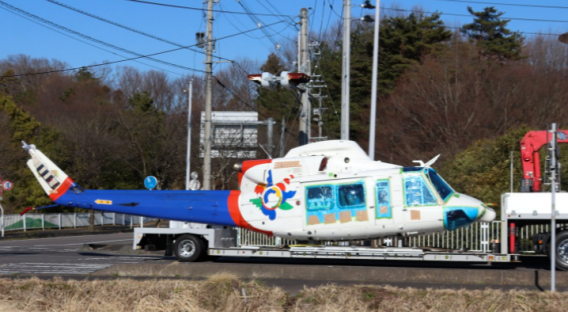 (Photos: TFAL via Twitter @)tkwskwaptfks)
(Photos: TFAL via Twitter @)tkwskwaptfks)
| Gifu Prefectural Disaster Prevention Aviation Unit | ||||
| Operator | Independently operated (Bell 412EP); Central Helicopter Service Ltd. (BK117) |
|||
| Base | JASDF Gifu | |||
| Date Formed | Apr. 1, 1994 (Gifu Air Rescue) | |||
| Helicopter Type | Reg’n | c/n | Name |
In Service Date(s)/ First Deployment Date |
| BK117C-1 | JA6724 (link) | 1094 | Wakaayu I |
Jan. 31, 1994* to ? |
| Bell 412EP | JA96GF (link) | 36124 | Wakaayu II |
Sept. 1996 (ex N6266T)** |
| Bell 412EP | JA119V | 36537 | Wakaayu III |
Mar. 23, 2011*** |
| BK117C-2 | JA21AR | 4032 | Wakaayu I |
See Note (+) below |
|
* Emergency operations from April 1, 1994 ** Written off in tragic accident when on rescue mission in mountains near Takayama, Gifu Prefecture, Sept. 11, 2009 *** Emergency operations from No. 17, 2011 (joint use with Gifu Prefectural Police) |
||||
| Last updated: Oct. 25, 2014 | ||||
 (Photo [March 2021]: Hotty758 via Twitter @Hotty7581)
(Photo [March 2021]: Hotty758 via Twitter @Hotty7581)
 A photo of a Gifu rescue crew and JA21AR being put through their paces during a training
A photo of a Gifu rescue crew and JA21AR being put through their paces during a training
observation visit by their counterparts from Aichi Prefecture.
(Photo [July 2019]: Aichi Air Rescue via Twitter @AichiAirRescue)
JA119V features the prefectural logo (below) above the word GIFU as a tail marking (link).
 (Image: Alex K via Wikimedia Commons)
(Image: Alex K via Wikimedia Commons)
JA21AR’s tail carries a cartoon-type pilot mascot ([link] and below).
 (Detail from July 2019 photo: Aichi Air Rescue via Twitter @AichiAir Rescue)
(Detail from July 2019 photo: Aichi Air Rescue via Twitter @AichiAir Rescue)
| Gunma Prefectural Disaster Prevention Aviation Unit | ||||
| Operator | Aero Asahi Corporation (formerly Toho Air Service) | |||
| Base | Gunma Heliport, Maebashi* | |||
| Date Formed | Jan. 1, 1997 | |||
| Helicopter Type | Reg’n | c/n | Name |
First Deployment Date |
| Bell 412EP | JA200G | 36132 | Haruna | May 20, 1997* |
| AW139** | JA10GR | 41571 | Haruna | |
|
* See Location Report 2 |
||||
| Last updated: Dec. 1, 2021 | ||||
 Bell 412EP JA200G Haruna overflies its home base of Gunma Heliport in Maebashi in 2013.
Bell 412EP JA200G Haruna overflies its home base of Gunma Heliport in Maebashi in 2013.
After 21 years’ service, this aircraft was lost in a tragic accident in August 2018.
 An inauguration ceremony for Gunma Prefecture’s AW139 was held on September 8, 2021.
An inauguration ceremony for Gunma Prefecture’s AW139 was held on September 8, 2021.
Learning from the tragic loss of the previous Haruna, this aircraft is fitted with a flight
recorder and safety features that include auto-hovering and collision avoidance systems.
(Photo: きりしま via Twitter @katori93cp)
Haruna’s tail marking comprises an element from the Gunma prefectural flag—a highly stylized representation of the kanji 群 (gun) in Gunma—superimposed within a fir tree design. (A report on J-HangarSpace’s September 2013 visit to Gunma Heliport can be found here [link].)
| Hiroshima Prefectural Disaster Prevention Aviation Unit | ||||
| Operator | Nakanihon Air Service Co., Ltd. | |||
| Base | Hiroshima Airport | |||
| Date Formed | July 11, 1996 (Hiroshima Maple) | |||
| Helicopter Type | Reg’n | c/n | Name |
In Service Date(s)/ First Deployment Date |
| Bell 412EP | JA6774 (link) | 36113 | Meipuru |
Feb. 1996 to ? (ex N32929) |
| AW139 | JA12HP | 41279 | Meipuru | Jan. 1, 2013 |
| Last updated: Aug. 8, 2013 | ||||
 (Above) Maple during a search and rescue demonstration flight at the firefighters’ event held in the
(Above) Maple during a search and rescue demonstration flight at the firefighters’ event held in the
city of Fukuyama, Hiroshima Prefecture, in April 2021 and (below) at its home base in
October 2018. The red tail marking is a stylizedヒ (hi) for Hiroshima, which
appears in white on a red background on the prefectural flag.
 (Photos: [Top] NAST40ZZ via Twitter @NART40VX; [above] うー via Twitter @hu_119)
(Photos: [Top] NAST40ZZ via Twitter @NART40VX; [above] うー via Twitter @hu_119)
| Hokkaido Prefectural Disaster Prevention Aviation Unit | ||||
| Operator | Joint operation with Hokkaido Prefectural Police (from Apr. 1, 2022, formerly Aero Asahi Corporation) |
|||
| Base | Sapporo-Okadama Airport | |||
| Date Formed | Apr. 1, 1996 (Hokkaido Government Air Rescue) | |||
| Helicopter Type | Reg’n | c/n | Name |
In Service Date(s)/ First Deployment Date |
| Bell 412 | JA9986 (link) | 33198 | Suzuran |
Dec. 2005* |
| Bell 412EP | JA6775 | 36109 | Hamanasu 2 | Apr. 1, 1996** |
| AS365N3+*** | JA01HR | 7027 | Hamanasu | |
|
* JA9986 originally registered Feb. 1990, returned to Aero Asahi circa Oct. 2012 ** JA6775 orginally registered Feb. 1996 (ex N3292N) |
||||
| Last updated: Apr. 4, 2022 | ||||
 A crewman keeps watch from a side window as the pilot manoeuvres Hamanasu (Sweet Briar) 2 at
A crewman keeps watch from a side window as the pilot manoeuvres Hamanasu (Sweet Briar) 2 at
Okadama Airport in October 2007. (Photo: “100 yen” via Wikimedia Commons)
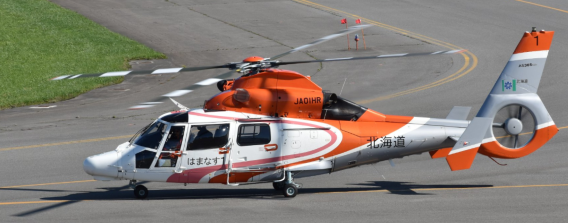 Flanked by thick and thin green vertical stripes, the seven-pointed star from the Hokkaido
Flanked by thick and thin green vertical stripes, the seven-pointed star from the Hokkaido
prefectural flag serves as an aircraft marking, in the case of Hiroshima’s AS365N3+
positioned nowadays above the nose and on the tail.
(Photo [Okadama, October 2019]: CJ@armingarea1836)
 The same prefectural marking is carried on a white background on the cockpit doors as
The same prefectural marking is carried on a white background on the cockpit doors as
well as on the nose and the tail of the Bell 412EP JA6775. Note that HOKKAIDO
GOVERNMENT appears in black lettering at the end of the tail boom.
(Photo: たかぽん via Twitter @takapochen)
| Hyogo Prefectural Disaster Prevention Aviation Unit | ||||
| Operator | (Independently operated)* | |||
| Base | Kobe Heliport | |||
| Date Formed | July 8, 1980* (Air Rescue Hyogo-Kobe) | |||
| Helicopter Type | Reg’n | c/n | Name |
In Service Date(s)/ First Deployment Date |
| BK117A-4 |
JA9909
|
1019 |
Hyogo
|
Aug. 1988 to July 1989** |
| BK117B-1 |
July 1989 to July 1996** |
|||
| BK117B-2 |
July 1996 to May 2007** |
|||
| BK117C-2 | JA28HY | 4009 | Hyogo | Mar. 31, 2006 |
|
* Commenced with Hyogo Prefetural Police Bell 222, operations now undertaken in conjunction with Kobe Municipal Disaster Prevention Bureau Aviation Unit ** First deployment dates for JA9909: Oct. 13, 1988 (as BK117A-4); July 14, 1989 (‘B-1); July 30, 1996 (‘B-2) |
||||
| Last updated: Aug. 9, 2013 | ||||
 A fine image of the Hyogo Prefecture aircraft taking part in the training exercise
A fine image of the Hyogo Prefecture aircraft taking part in the training exercise
conducted on National Disaster Preparedness Day (September 1) 2021.
(Photo: ひょーご via Twitter @0128BKHY)
 As usual, the marking at the base of the tail is taken from the Hyogo Prefecture flag (above). This
As usual, the marking at the base of the tail is taken from the Hyogo Prefecture flag (above). This
comprises a geographic representation of a stylized 兵 (hyō, meaning soldier) from Hyogo
sandwiched in between two wavy lines, the upper denoting the Sea of Japan,
the lower the Pacific Ocean. (Image: Kzaral via Wikimedia Commons)
| Ibaraki Prefectural Disaster Prevention Aviation Unit | ||||
| Operator | Tsukuba Aviation Co., Ltd. (TKB) | |||
| Base | Tsukuba Heliport, Tsukuba | |||
| Date Formed | Apr. 1, 1995 (Tsukuba Air Rescue) | |||
| Helicopter Type | Reg’n | c/n | Name |
In Service Date(s)/ First Deployment Date |
| BK117B-1 | JA6743 (link) | 1101 | Tsukuba |
Mar. 1995 to Mar. 2011 |
| BK117C-2 | JA298R | 4016 | Tsukuba | Nov. 15, 2010* |
| BK117D-3 | JA298B | 21120 | Tsukuba | KHI order Oct. 26, 2021* |
| * JA298R first registered Aug. 2010, sold and reg’d to Shows Leasing, Jan. 2024 * JA298B first registered Jan. 2023 |
||||
| Last updated: Oct. 27, 2024 | ||||
 A Tsukuba Air Rescue crew joins in the search for a missing person along a stretch of water in
A Tsukuba Air Rescue crew joins in the search for a missing person along a stretch of water in
the city of Kashima, Ibaraki Prefecture, October 2017. (Photo: JA283AR via Twitter @ja283)
The symbol from the Ibaraki Prefecture flag (below) carried on the aircraft’s tail is the bud of a white rose, the prefecture’s flower.
 (Image: Monaneko via Wikimedia Commons)
(Image: Monaneko via Wikimedia Commons)
| Ishikawa Prefectural Disaster Prevention Aviation Unit | ||||
| Operator | Nakanihon Air Service Co., Ltd. | |||
| Base | Komatsu Airport | |||
| Date Formed | Apr. 1, 1997 (Ishikawa Air Rescue) | |||
| Helicopter Type | Reg’n | c/n | Name |
In Service Date |
| Bell 412EP | JA893F | 36134 | Hakusan | Apr. 1, 1997* |
| AW139 | JA893K | 32040 | Hakusan | Apr. 1, 2025 |
| * Aircraft first registered Dec. 1996 (ex N34957). Oct. 2019 order for Bell 412EPI cancelled. | ||||
| Last updated: Apr. 17, 2025 | ||||
 Originally planned for replacement by a Bell 412EPI, the original Hakusan visits Kounan Airport
Originally planned for replacement by a Bell 412EPI, the original Hakusan visits Kounan Airport
in Okayama Prefecture in August 2021. (Photo: イージス艦 via Twitter @SPY_1D)
 Countdown to the withdrawal from use of the first-generation Hakusan commenced with the
Countdown to the withdrawal from use of the first-generation Hakusan commenced with the
arrival of its successor, pictured here on September 30, 2024, the day of its delivery
to Komatsu Airport. (Photo: YOSHIRJNK via X @YOSHIRJNK)
Seen more clearly here (link), the blue tail marking is a stylized version of 石川 (the kanji for Ishikawa). The left-hand element is in the geographical shape of the prefecture, the right presumably representing the sea rather than a river (kawa).
| Iwate Prefectural Disaster Prevention Aviation Unit | ||||
| Operator | Toho Air Service Co., Ltd. | |||
| Base | Hanamaki Airport | |||
| Date Formed | Aug. 1, 1996 (Iwate Air Rescue) | |||
| Helicopter Type | Reg’n | c/n | Name |
First Deployment Date |
| Bell 412EP | JA6776 (link) | 36114 | Himekami | Mar. 1996* |
| AW139 | JA10TE | 41506 | Himekami | Flt tested Jan. 2016 |
| * Aircraft first registered Feb. 1996 (ex N3293A), replaced by AW139 and with Nagano DPAU in Sept. 2018 | ||||
| Last updated: Dec. 12, 2018 | ||||
 (Photo [Chofu Airport, Tokyo, Jan. 2020]: Wilco via Twitter @Wilco11886715)
(Photo [Chofu Airport, Tokyo, Jan. 2020]: Wilco via Twitter @Wilco11886715)
 (Above) The prefectural flag symbol of a stylized 岩 (iwa, meaning rock), seen in the
(Above) The prefectural flag symbol of a stylized 岩 (iwa, meaning rock), seen in the
Japanese for Iwate Prefecture beneath, and (below) the markings sported on the hoist.
The name Himekami is taken from a mountain near Morioka, Iwate Prefecture. (Photos: ただひろ via Twitter @join20136earth)
(Photos: ただひろ via Twitter @join20136earth)
| Kagawa Prefectural Disaster Prevention Aviation Unit | ||||
| Operator | Shikoku Air Service Co., Ltd. | |||
| Base | Takamatsu Airport | |||
| Date Formed | Jan. 20, 1994 (Kagawa Air Rescue) | |||
| Helicopter Type | Reg’n | c/n | Name |
In Service Date(s)/ First Deployment Date |
| BK117B-2 | JA6729 (link) | 1095 | Olive |
Mar. 1994 to Dec. 2008 |
| BK117C-2 | JA119K | 4013 | Olive II | Feb. 1, 2009* |
| * Aircraft first registered Oct. 2008 | ||||
| Last updated: Aug. 8, 2013 | ||||
 The current Kagawa aircraft carries on its upper fuselage the stylized version, rotated 90 degrees
The current Kagawa aircraft carries on its upper fuselage the stylized version, rotated 90 degrees
to the left, of the katakana カ (ka) for Kagawa, which appears on the prefectural flag. The flag
is olive green, olive being the prefectural tree and hence the aircraft’s name.
(Photo [Oct. 2020]: はちきん via Twitter @JA6928)
| Kagoshima Prefectural Disaster Prevention Aviation Unit | ||||
| Operator | Kagoshima International Aviation Co., Ltd. | |||
| Base | Makurazaki Airfield | |||
| Date Formed | Apr. 1, 1998 (Air Rescue Crew) | |||
| Helicopter Type | Reg’n | c/n | Name |
First Deployment Date |
| Bell 412EP | JA97KG | 36175 | Satsuma | June 1, 1998* |
| AW139** | JA18KG | 41538 | Satsuma | |
| * Aircraft first registered Dec. 1997 (ex N6317X) ** Delivery of AW139 announced by Mitsui Bussan Mar. 4, 2019 |
||||
| Last updated: Sept. 18, 2021 | ||||
 (Photo [2020]: ひょーご via Twitter @0128BKHY)
(Photo [2020]: ひょーご via Twitter @0128BKHY)
 Kyushu Electric Power Company (Kyuden) personnel prepare to board the Kagoshima Air Rescue
Kyushu Electric Power Company (Kyuden) personnel prepare to board the Kagoshima Air Rescue
Crew’s AW139 at Makurazaki Airport in early September 2020. The helicopter was drafted in to
speed up the restoration of power on Nakanoshima, one of the prefecture’s outlying islands,
following widespread supply disruption caused by a typhoon.
(Photo: 九電グループ [Kyuden Group] via Twitter @Kyuden_Official)
Seen clearly in this image (link), the current aircraft carries a design from an alternative Kagoshima Prefecture flag. This consists of two pairs of curves, one sweeping up, the other down, to represent the wind and waves in the form of a K for Kagoshima.
| Kochi Prefectural Disaster Prevention Aviation Unit | ||||
| Operator | (Independently operated) | |||
| Base | Kochi-Ryoma Airport | |||
| Date Formed | Feb. 1, 1996 | |||
| Helicopter Type | Reg’n | c/n | Name |
First Deployment Date |
| S-76B | JA6759 (link) | 760428 | Ryoma | Apr. 22. 1996* (Kochi Air Rescue) |
| AW139 | JA05FD | 41324 | Otome | April 1, 2014** |
| JA06FD | 31925 | Apr. 2021 | ||
| * Start of operations. Aircraft first registered Nov. 1995 ** JA05FD operated by Fire and Disaster Management Agency (FDMA) |
||||
| Last updated: Sept. 28, 2021 | ||||
 (Photo [Yao Airport, Osaka, Feb. 2021]: マサさん via Twitter @RJOY_spotter)
(Photo [Yao Airport, Osaka, Feb. 2021]: マサさん via Twitter @RJOY_spotter)
| Kumamoto Prefectural Disaster Prevention Aviation Unit | ||||
| Operator | Amakusa Airlines Co., Ltd. | |||
| Base | Kumamoto Airport | |||
| Date Formed | Apr. 1, 2001 (Air Rescue Kumamoto) | |||
| Helicopter Type | Reg’n | c/n | Name |
First Deployment Date |
| AS365N3 | JA15KM (link) | 6585 | Hibari | Feb. 13, 2001* |
| AS365N3+ | JA90MT | 7009 | Hibari | April 2018 |
|
* Aircraft first registered Feb. 2001 |
||||
| Last updated: May 2, 2018 | ||||
 The second-generation Hibari (Skylark) during a rooftop rescue training exercise. The hook-like
The second-generation Hibari (Skylark) during a rooftop rescue training exercise. The hook-like
tail marking is actually the stylized ク (ku, for Kumamoto) in the shape of Kyushu that forms
the prefectural flag’s motif. (Photo [Feb. 2019]: MF10L33 via Twitter @ashigara178)
 Both horizontal tail end-plates feature an image of Kumamoto Prefecture’s popular Kumamon
Both horizontal tail end-plates feature an image of Kumamoto Prefecture’s popular Kumamon
bear mascot carrying a Kumamoto rescue pilot’s helmet. (Photo [taken prior to full service
entry, Amakusa Airport, Jan. 2018]: いちカメ via Twitter @amakusablue)
| Mie Prefectural Disaster Prevention Aviation Unit | ||||
| Operator | Nakanihon Air Service Co., Ltd. | |||
| Base | Tsushi Isewan Heliport | |||
| Date Formed | Apr. 1, 1993 (Mie Disaster Prevention Unit) | |||
| Helicopter Type | Reg’n | c/n | Name |
First Deployment Date |
| Bell 412EP | JA6703 (link) | 36045 | Mie | Mar. 17, 1993* |
| AW139 | JA119M | 41515 | Mie | Flt tests early 2017 |
| * Aircraft first registered Jan. 1993 (ex N31409) | ||||
| Last updated: July 31, 2017 | ||||
 Part of the fleet belonging to Nakanihon Air Service, the Mie Disaster Prevention Unit’s aircraft
Part of the fleet belonging to Nakanihon Air Service, the Mie Disaster Prevention Unit’s aircraft
operator, Bell 412 JA6767 Mie plays a key role during a rescue mission on Mount Gozaisho in
November 2010. On occasion, prefectures operating just one helicopter are provided with a
temporary replacement to cover their usual aircraft’s extended maintenance absences.
This same aircraft has also seen service with the Aichi Prefecture unit (q.v.).
(Photo: Alpsdake via Wikimedia Commons)
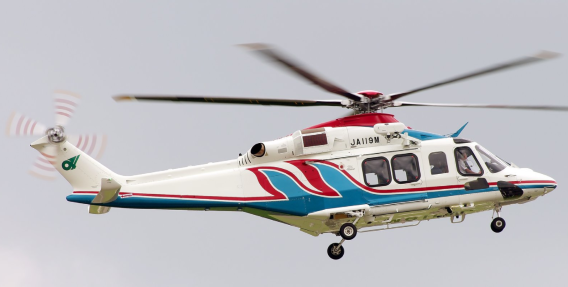 The current aircraft’s registration simply comprises 119, the emergency phone number in Japan,
The current aircraft’s registration simply comprises 119, the emergency phone number in Japan,
and M for Mie. The tail marking is the stylized hiragana み (mi) of the prefectural flag, which
appears in white on the flag due to Mie’s association with the pearl industry; presumably
this accounts for the aircraft being predominantly white.
(Photo [July 2016]: しだーぱむぱむ® ver.2.01 via Twitter @EPSHV)
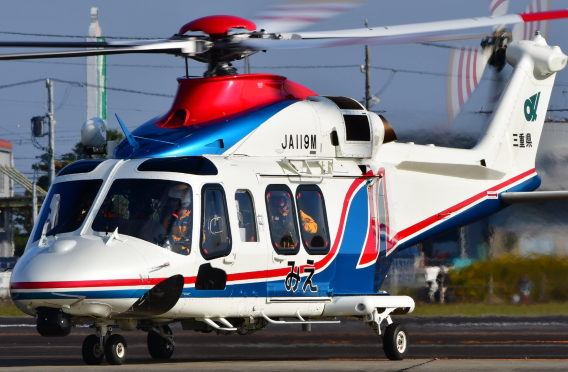 Mie Disaster Prevention Unit’s AW139 at JGSDF Akeno, November 2019
Mie Disaster Prevention Unit’s AW139 at JGSDF Akeno, November 2019
(Photo: ぷに一 [@NikonskyF16])
| Miyagi Prefectural Disaster Prevention Aviation Unit | ||||
| Operator | Tohoku Air Service, Inc. | |||
| Base | Sendai Airport | |||
| Date Formed | Apr. 1, 1991 (Miyagi Disaster Prevention Aviation Corps) | |||
| Helicopter Type | Reg’n | c/n | Name |
In Service Date(s)/ First Deployment Date |
| BK117B-1 |
JA6654 |
1102 |
Miyagi
|
1991 to Feb. 1996 |
| BK117B-2 |
Feb. 1996 to circa 2010 |
|||
| BK117C-2 | JA612M (link) | 4011 |
(See Notes)
|
|
| BK117C-1 | JA6708 | 1104 | ||
| AS365N2 | JA6688 | 6428 | ||
| AS365N3+ | JA04FD | 6960 | Miyagi | Aug. 6, 2013 (See Notes) |
|
Notes: JA612M first registered Jan. 2008, commenced operations Mar. 1 same year. Damaged beyond repair by tsunami at Sendai Airport, Mar. 11, 2011 JA6708 formerly Nagasaki Prefectural Disaster Prevention aircraft, in service bearing full markings Aug. 2012 (unmarked in Sept. 2012), eventually passed to private air ambulance service JA6688 formerly Kyoto Municipal Disaster Prevention aircraft, unmarked in Mar. 2012 prior to receiving Miyagi/Eurocopter markings, leased from Oct. 1, 2012 to July 31, 2013 (Also, besides three longer BK117 leases 2011–2012, leased BK117B-1 JA6662 for a month Feb. 2012) JA04FD loaned from Fire and Disaster Management Agency (FDMA, part of Ministry of Internal Affairs and Communications) since Jan. 2012. Announced as new Miyagi Aug. 2013. |
||||
| Last updated: Aug. 9, 2013 | ||||
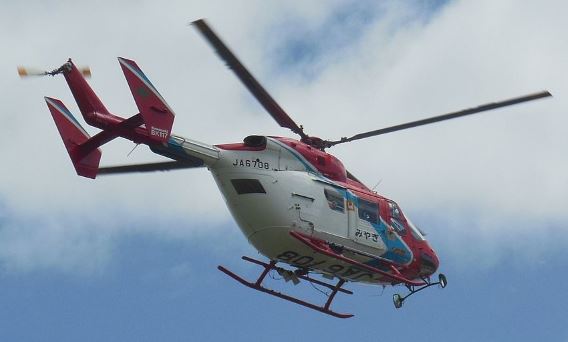 Formerly operated by the Nagasaki Air Rescue, BK117C-1 JA6708 was drafted in to replace a
Formerly operated by the Nagasaki Air Rescue, BK117C-1 JA6708 was drafted in to replace a
Miyagi aircraft damaged beyond economic repair by the tsunami of March 11, 2011, and was
one of the three BK117s to bear the prefecture’s name. Photographed when flying over
its Sendai Airport base in August 2012, the aircraft was later sold to a private
air ambulance service. (Photo: Tettoumania2358 via Wikimedia Commons)
 Officially named Miyagi in 2013, JA04FD retains its FDMA titling and tail markings. The aircraft
Officially named Miyagi in 2013, JA04FD retains its FDMA titling and tail markings. The aircraft
visited JGSDF Kasuminome in April 2018 for the 61st anniversary of the garrison’s establishment.
(Photo: 抹茶猫 via Twitter @matchaneco)
 More clearly seen in this photo, taken in September 2021, Miyagi does carry the design from the
More clearly seen in this photo, taken in September 2021, Miyagi does carry the design from the
prefectural flag on its stabilizer end-plates. The design comprises a green three-leaf clover
edged in white in the form of the み (mi) of Miyagi; on the flag, this appears in white on
a green background. (Photo: ファントムIIオジロ via Twitter@SuKuym8XeXh57DO)
| Miyazaki Prefectural Disaster Prevention Aviation Unit | ||||
| Operator | Kagoshima International Aviation Co., Ltd. | |||
| Base | Miyazaki Airport | |||
| Date Formed | Oct. 1, 2004 (Miyazaki Air Rescue Team) | |||
| Helicopter Type | Reg’n | c/n | Name |
First Deployment Date |
| Bell 412EP | JA99MZ | 36328 | Aozora | Oct. 1, 2004* |
| * Aircraft first registered July 2004 NOTE: Order for SUBARU 412EPX announced Oct. 2023 for delivery in 2025 |
||||
| Last updated: Dec. 10, 2023 | ||||
 The Miyazaki Prefecture Bell 412EP was present at the Nyutabaru air show in December 2012.
The Miyazaki Prefecture Bell 412EP was present at the Nyutabaru air show in December 2012.
Somewhat at odds with its colour scheme, the name on the side of the cabin, Aozora, means
blue sky. When read in Japanese, the registration numbers nine-nine (kyū-kyū) also mean
emergency; the letters are simply derived from MiyaZaki.
 The prefectural flag that serves as a tail marking includes a stylized katakana ミ (mi)
The prefectural flag that serves as a tail marking includes a stylized katakana ミ (mi)
in the form of steps to symbolize progress. The steps are yellow to symbolize Miyzaki’s
reputation as a sunny location. (Image: Ninane via Wikimedia Commons)
| Nagano Prefectural Disaster Prevention Aviation Unit | ||||
| Operator | (Independently operated) | |||
| Base | Matsumoto Airport | |||
| Date Formed | Apr. 1, 1997 (Nagano Air Rescue Team) | |||
| Helicopter Type | Reg’n | c/n | Name |
First Deployment Date |
| Bell 412EP | JA97NA | 36135 | Arupusu (Alps) | Apr. 1, 1997* |
| Bell 412HP** | JA412V | 30618 | Aug. 2014 to Dec. 2015 | |
| Bell 412EP*** | JA6776 | 36114 | Sept. 1, 2018 | |
| Bell 412EPI+ | JA02NA | 37042 | Arupusu (Alps) | |
| * Aircraft first registered Jan. 1997 (ex N34961) Written off in crash during training exercise Mar. 5, 2017 ** Kagoshima International Aviation Co., Ltd. aircraft used as temporary cover. *** Operated by Iwate Prefecture until 2016, stop-gap measure pending ‘EPI delivery + Ordered Nov. 7, 2018, delivery ceremony Nov. 16, 2020. See postscript to Mar. 5, 2017 Bulletin Board story |
||||
| Last updated: Dec. 27, 2020 | ||||
 The Nagano Air Rescue Team’s distinctively coloured Bell 412EP at rest amid the disappearing
The Nagano Air Rescue Team’s distinctively coloured Bell 412EP at rest amid the disappearing
snow at Matsumoto Airport in April 2010. This aircraft was lost in a tragic
accident in March 2017. (Photo: contri via Wikimedia Commons)
 Alps (Nagano Air Rescue Team website photo gallery)
Alps (Nagano Air Rescue Team website photo gallery)
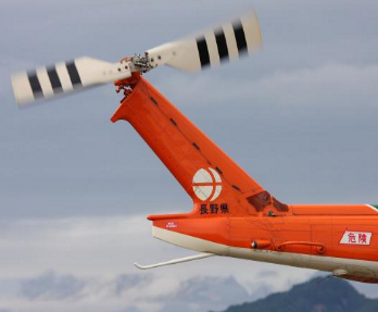 Alps was the first helicopter in Japan to be modified with a Fast Fin or Dual Tailboom Strakes (DTS)
Alps was the first helicopter in Japan to be modified with a Fast Fin or Dual Tailboom Strakes (DTS)
system, a modification designed to improve handling at low speed and in the hover. The fin bore the
logo that appears on the Nagano Prefecture flag, a stylized ナ (na) for Nagano that has the
appearance of a bird in flight. (Nagano Air Rescue Team website photo gallery)
 The Bell 421EPI destined for Nagano Prefecture during flight testing. The unit officially accepted
The Bell 421EPI destined for Nagano Prefecture during flight testing. The unit officially accepted
delivery of its new Alps on November 16, 2020. Built by Bell, the aircraft was procured and
equipped by SUBARU. (Photo [Utsunomiya, Sept. 2020]: Senda Jet via Twitter @santa463)
 The Nagano Air Rescue Team pay a visit to their counterparts in the Yamanashi Prefecture aviation
The Nagano Air Rescue Team pay a visit to their counterparts in the Yamanashi Prefecture aviation
unit during a long-range disaster response training exercise held on March 11, 2021, the
the 10th anniversary of the Great East Japan Earthquake. The team also dropped
in on the Gunma- and Tokyo-based units.
(Photo [Mar. 8, 2021]: Nagano Air Rescue Team via Twitter @AirNagano)
| Nagasaki Prefectural Disaster Prevention Aviation Unit | ||||
| Operator | Oriental Air Bridge Co., Ltd (ORC) | |||
| Base | JMSDF Ohmura | |||
| Date Formed | Apr. 1, 1996 (Nagasaki Air Rescue) | |||
| Helicopter Type | Reg’n | c/n | Name |
In Service Date(s)/ First Deployment Date |
| BK117B-1 |
JA6708
|
1104 |
Nagasaki |
(Mar. 1993) to Feb. 1995 |
| BK117B-2 |
Feb. 1995 to Feb. 2001 |
|||
| BK117C-1 |
Feb. 2001 to ? |
|||
| AS365N3 | JA119Z | 6939 | Nagasaki | Apr. 1, 2012* |
| * First registered March 2012, test flights conducted at Osaka-Itami Airport same month | ||||
| Last updated: Aug. 10, 2013 | ||||
 The current Nagasaki photographed on a hazy day in September 2021 and showing its true colours
The current Nagasaki photographed on a hazy day in September 2021 and showing its true colours
on a brighter day when visiting the city of Yatsushiro, Kumamoto Prefecture, back in
November 2012 (link). (Photo: くう太郎 via Twitter @shimashima_go)
Loosely in the shape of an N and also of a dove of peace, the prefectural flag marking displayed prominently on the sides of the fuselage is blue to symbolize the sea and sky.
 Two sides of BK117B JA6708 at JMSDF Omura in May 1993 (above) and May 1995 (below) . . .
Two sides of BK117B JA6708 at JMSDF Omura in May 1993 (above) and May 1995 (below) . . .
 . . . and in colour now as a BK117C-1, again at JMSDF Omura, May 2003
. . . and in colour now as a BK117C-1, again at JMSDF Omura, May 2003
 (Photos: Takao Kadokami)
(Photos: Takao Kadokami)
| Nara Prefectural Disaster Prevention Aviation Unit | ||||
| Operator | Toho Air Service Co., Ltd. | |||
| Base | Nara Prefectural Heliport, Nara | |||
| Date Formed | Oct. 1, 1998 (Nara Air Rescue) | |||
| Helicopter Type | Reg’n | c/n | Name |
In Service Date(s)/ First Deployment Date |
| Bell 412EP | JA99NA | 36214 | Oct. 1, 1998?* | |
| Bell 412EP | JA20NA | 36243 | Yamato 2000 | Aug. 22, 2000** |
|
* (Ex C-GBUB, N4446M). Written off in non-fatal accident at Totsukawa, Nara Prefecture, July 13, 1999 ** Aircraft first registered May 2000 (ex N6400J) |
||||
| Last updated: Dec. 10, 2023 | ||||
 (Photo [April 2020]: 回収犬 via Twitter @retriever666)
(Photo [April 2020]: 回収犬 via Twitter @retriever666)
 (Photo [Sept. 2021]: TA_KU via Twitter @ta_ku_nkn073)
(Photo [Sept. 2021]: TA_KU via Twitter @ta_ku_nkn073)
Not immediately obvious from its shape, the prefectural flag marking on the Yamato 2000‘s tail is said to be a stylized katakana ナ (na) of Nara. The choice of colour was simple, as this dark red has apparently been associated with Nara since ancient times, but the meanings of the 1968 design’s elements are, as tends to be the case, somewhat more esoteric. Basically, the disc represents Nature, the smaller white disc harmony, and the integrated horizontal rectangle constant progress.
| Niigata Prefectural Disaster Prevention Aviation Unit | ||||
| Operator | Aero Asahi Corporation | |||
| Base | Niigata Airport | |||
| Date Formed | Jan. 20, 1995 (Niigata Air Rescue Crew) | |||
| Helicopter Type | Reg’n | c/n | Name |
First Deployment Date |
| S-76B | JA6747 | 760414 | Hakuchou | Feb. 28, 1995* |
| AW139 | JA15AR | 41386 | Hakuchou** | |
|
* Aircraft first registered Dec. 1994 (ex N3292N), started operations April 1, 1995 ** Registered to Mitsui Bussan Aerospace, Mar. 5, 2015 |
||||
| Last updated: Sept. 1, 2021 | ||||
 The Niigata Air Rescue S-76B passes low over its home base in August 2011. This aircraft was
The Niigata Air Rescue S-76B passes low over its home base in August 2011. This aircraft was
replaced by the AW139 early in 2016. (Photo: “Cp9asngf” via Wikimedia Commons)
 Hakuchou (Swan) leaving its usual nesting place on a training mission, May 2021.
Hakuchou (Swan) leaving its usual nesting place on a training mission, May 2021.
(Photo: 偽プリーストvia Twitter @NisePri)
 The Niigata Air Rescue Crew receive a visit from the Nagano Air Rescue Team, which was on
The Niigata Air Rescue Crew receive a visit from the Nagano Air Rescue Team, which was on
a long-range disaster response training exercise held three days before the
10th anniversary of the Great East Japan Earthquake.
(Photo [Mar. 8, 2021]: Nagano Air Rescue Team via Twitter @AirNagano)
Adopted in April 1992, the Niigata Prefecture symbol marking that has been applied to the fuselages of both Hakuchou is of a simple white fan shape within a sea blue disc. The design is said to represent the prefecture disseminating its internationality and positivity across the Sea of Japan and out into the wider world.
| Oita Prefectural Disaster Prevention Aviation Unit | ||||
| Operator | Kyushu Airways Co., Ltd. | |||
| Base | Ou Airfield, Bungo-Ono | |||
| Date Formed | Apr. 1, 1997 (Air Rescue Oita) | |||
| Helicopter Type | Reg’n | c/n | Name |
First Deployment Date |
| BK117C-1 | JA01TA | 1111 | Toyokaze | June 1, 1997* |
| BK117C-2 | JA104W | 4041 | Toyokaze | Flt tested Aug. 2016** |
|
* Aircraft first registered Mar. 1997, reg’n cancelled and sold to NZ May 2018 Order for H145/BK117D-3 announced Aug. 2023, Planned for delivery Sept. 2025, service entry from fiscal 2026 |
||||
| Last updated: Dec. 3, 2023 | ||||
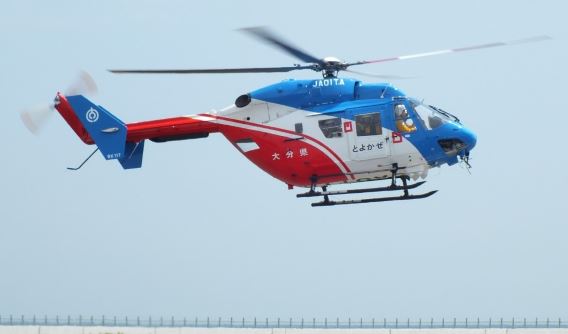 Air Rescue Oita’s BK-117C-1 Toyokaze (“Excellent Wind”) in 2016, the
Air Rescue Oita’s BK-117C-1 Toyokaze (“Excellent Wind”) in 2016, the
year its replacement arrived. (Photo: Takao Kadokami)
 Oita’s second-generation Toyokaze seen during test flights with a belly-mounted firefighting system
Oita’s second-generation Toyokaze seen during test flights with a belly-mounted firefighting system
in January 2018. Instead of the device from the Oita Prefecture’s flag, the circular tail marking is
the prefectural emblem, which dates from 1911. (Photo: わかちい via Twitter @wakachii_NKM)
| Okayama Prefectural Disaster Prevention Aviation Unit | ||||
| Operator | Shikoku Air Service Co., Ltd. | |||
| Base | Okayama Airport | |||
| Date Formed | Apr. 1, 2009 (Okayama Pref. Air Rescue Team) | |||
| Helicopter Type | Reg’n | c/n | Name |
First Deployment Date |
| Bell 412EP | JA119H | 36503 | Kibi | June 8, 2009* |
| * Aircraft first registered in Mar. 2009 | ||||
| Last updated: Jan. 30, 2022 | ||||
 Kibi during a demonstration flight at Okayama Airport in November 2019.
Kibi during a demonstration flight at Okayama Airport in November 2019.
(Photo: なぎさ via Twitter @KatanoNagisa)
Seen in a photo taken in December 2018 (link), Kibi’s tail marking seems to contain a downward-pointing arrow and the silhouette of an apple, but the design is in fact a stylized representation of the 岡 (oka, meaning hill) in Okayama. Although in white on the aircraft, on the prefectural flag this design is in gold against a purple background.
The aircraft’s name, literally meaning millet (a crop grown locally), was selected from around 1,270 applications received from people inside and outside the prefecture. Sounding the same as Kibi province, the ancient area now known as Okayama Prefecture, the name also conjures up the image of the unit being kibikibi (quick to respond). (The word kibi can also mean the tail of an aircraft.)
| Saga Disaster Prevention Aviation Unit | ||||
| Operator | SGC Saga Aviation Co., Ltd. | |||
| Base | Saga International Airport | |||
| Date Formed | Apr. 1, 2020 | |||
| Helicopter Type | Reg’n | c/n | Name |
First Deployment Date |
| BK117D-2* | JA153L | 36094 | (Mar/Apr. 2021) | |
| * Aircraft flight tested from Gifu, August 2020 (See Bulletin Board) | ||||
| Last updated: Oct. 10, 2020 | ||||
 Saga Prefecture acquired the first BK-117D-2 for emergency service use in Japan, and Kachidoki is
Saga Prefecture acquired the first BK-117D-2 for emergency service use in Japan, and Kachidoki is
seen here on a crew training flight in April 2021, soon after its introduction into service. A standard
dictionary meaning of kachidoki is “triumphant shout”, but in this case the name has been obscurely
derived from the Japanese saying that a magpie works wonders for its home region.
(Photo: MOR1 via Twitter @anm10w3079)
 Another view of the Saga Prefecture aircraft in April 2021, during hoist training. Like the Oita
Another view of the Saga Prefecture aircraft in April 2021, during hoist training. Like the Oita
aircraft, Kachidoki carries the prefectural emblem not the flag device as its tail marking. In
blue on the aircraft, this is usually white on a green flag. Adopted in 1992, the design is
basically described as representing Saga’s fertile soil and the sea.
(Photo: ふぁんとむ改 via Twitter @rjff_spotter)
The aircraft also promotes local strawberry farms through its specially selected registration. A play on words in that 153 (ichi-go-san) can also mean Mr. Strawberry [Grower], the word イチゴさん appears beneath the aircraft’s registration (and also in the alphabet as ichigosan) as elements in the logo that has promoted the new Ichigosan variety of locally produced strawberry since 2018.
| Saitama Prefectural Disaster Prevention Aviation Unit | ||||
| Operator | Honda Airways Co., Ltd. | |||
| Base | Honda Airport, Kawajima | |||
| Date Formed | Jan. 1, 1991 (Saitama Disaster Prevention Air Squadron [DPAS]) | |||
| Helicopter Type | Reg’n | c/n | Name |
In Service Date(s)/ First Deployment Date |
| AS365N2 | JA6644 | 6386 | Arakawa 1 | Jan. 1991 to July 2007 |
| AS365N3 | JA31TM (link) | 6729 | Jan. 2006* | |
| AS365N3 | JA31KN | 6587 | Arakawa 2 | Apr. 1, 2001** |
|
AW139* |
JA31AR | 41275 | Arakawa 3 | |
| JA03FD | 41274 | Arakawa 4 | ||
|
* JA31TM written off in tragic accident during mountain rescue mission near Otaki, Saitama Prefecture, July 25, 2010 * Both AW139s first registered in Dec. 2011; JA03FD operated by Fire and Disaster Management Agency (FDMA) |
||||
| Last updated: July 3, 2023 | ||||
 Arakawa 2 being put through its paces on a hazy day at Honda Airport in Saitama, May 2005.
Arakawa 2 being put through its paces on a hazy day at Honda Airport in Saitama, May 2005.
 The Fire and Disaster Management Agency (FDMA) AW139 that operates in conjunction
The Fire and Disaster Management Agency (FDMA) AW139 that operates in conjunction
with the Saitama DPAS during mountain rescue training conducted at the OPark Bio
Resort Hotel and Spa complex in the town of Ogose, Saitama Prefecture.
(Photo [Nov. 2019]: なぎさ via Twitter @KatanoNagisa)
 (Photo [posted September 2021]: Saitama DPAS via Facebook [link])
(Photo [posted September 2021]: Saitama DPAS via Facebook [link])
 (Image: Monaneko via Wikimedia Commons)
(Image: Monaneko via Wikimedia Commons)
The design for the prefectural flag (above) was adopted in September 1964, the month before the start of the Tokyo Olympics, some events of which were held in neighbouring Saitama. The circle comprises 16 magatama (comma-shaped beads), artefacts representative of items found in the prefecture’s clusters of ancient burial mounds. Each one symbolizes a natural phenomenon, character trait or aspect of life, such as the infrastructure development that was under way at that time.
 (Photo: Saitama DPAS via Facebook page [link])
(Photo: Saitama DPAS via Facebook page [link])
Although partly obscured on occasions when the belly-mounted firefighting equipment is fitted (above), the now retired AS365N3 JA31KN (also below) carries the prefectural marking on its undersides, as did the ill-fated Arakawa 1 (JA31TM).
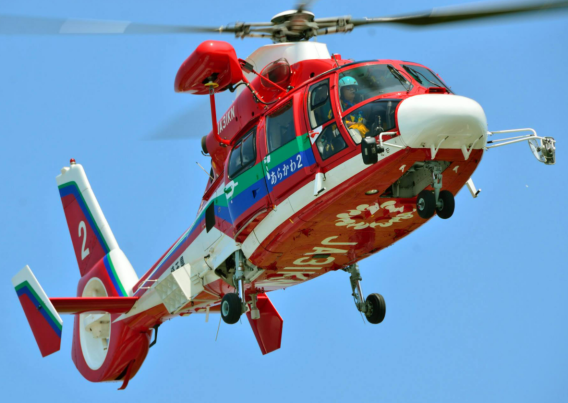 (Photo: Saitama DPAS via Facebook page [link])
(Photo: Saitama DPAS via Facebook page [link])
 Of the two AW139s, only the bona fide Saitama DPAS aircraft Arakawa 3 sports the
Of the two AW139s, only the bona fide Saitama DPAS aircraft Arakawa 3 sports the
prefectural emblem on its undersides. (Photo: Saitama DPAS via Facebook [link])
 (Image: Saitama DPAS via Facebook [link])
(Image: Saitama DPAS via Facebook [link])
| Shiga Prefectural Disaster Prevention Aviation Unit | ||||
| Operator | Osaka Aviation Inc. | |||
| Base | Hino Heliport, Osaka Airport | |||
| Date Formed | Apr. 1, 1996 (Air Rescue Shiga) | |||
| Helicopter Type | Reg’n | c/n | Name |
In Service Date(s)/ First Deployment Date |
| BK117B-2 | JA6763 | 1105 | Awa-umi | Dec. 1995 to 2012* |
| AS365N3 | JA25LB | 6926 | Biwa | Sept. 20, 2011** |
|
* Sold to Australian operator April 2012 ** First registered Dec. 2010 |
||||
| Last updated: Oct. 10, 2021 | ||||
 A fine shot of Air Rescue Shiga’s distinctive AS365N3 in action on Mount Ibuki, Maibara, in
A fine shot of Air Rescue Shiga’s distinctive AS365N3 in action on Mount Ibuki, Maibara, in
February 2014. (Photo: Alpsdake via Wikimedia Commons)
The seemingly winged prefectural flag symbol sported on Biwa’s tail is a stylized version of the name written in katakana (シガ) said to represent harmony and progress. In its flag form, the symbol is white on a blue background so that the central part represents Lake Biwa, the attraction for which the prefecture is most famous; here, the blue lettering serves that purpose.
 Shiga Prefecture’s Awa-umi (Pale Sea) stands out vividly against an ominous sky at Fukui Airport
Shiga Prefecture’s Awa-umi (Pale Sea) stands out vividly against an ominous sky at Fukui Airport
in October 2009. Its green shape being that of Shiga Prefecture, the nose marking
depicted a cartoon mother and baby Lake Biwa catfish (link).
(Photo: みいさん via Twitter @miisandesu)
| Shimane Prefectural Disaster Prevention Aviation Unit | ||||
| Operator | Central Helicopter Service Ltd. | |||
| Base | Izumo Airport | |||
| Date Formed | Apr. 1, 1994 (Shimane Air Rescue Team [SART]) | |||
| Helicopter Type | Reg’n | c/n | Name |
In Service Date(s)/ First Deployment Date |
| BK117B-2 | JA6723 (link) | 1092 | Hakuchou | Jan. 1995 to 2013* |
| BK117C-2 | JA32AR | 4022 | Hakuchou | Nov. 29, 2012** |
| * New U.S. registration N521KK pending May 2013. (SART website states in service 1994 to Jan. 17, 2013) ** First registered July 2012, SART website gives Feb. 25, 2013 as start of operations |
||||
| Last updated: Sept. 30, 2021 | ||||
 Shimane’s BK117C-2 in October 2020 (above) and, in a different light (below), at
Shimane’s BK117C-2 in October 2020 (above) and, in a different light (below), at
the prefecture’s Izumo Airport in March 2019.
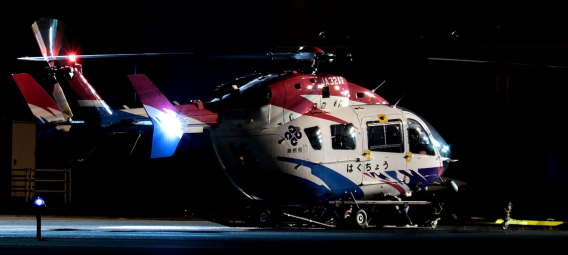 (Photos: [Top] はちきんvia Twitter @JA6928; [above] たろすけ via Twitter @trooperc3po)
(Photos: [Top] はちきんvia Twitter @JA6928; [above] たろすけ via Twitter @trooperc3po)
 Taken from the prefectural flag, the marking positioned aft of the cabin windows is of four
Taken from the prefectural flag, the marking positioned aft of the cabin windows is of four
(shi) stylized katakana マ (ma) arranged in a circle above the black kanji 島根県
(Shimane Prefecture). On the flag the marking usually appears in gold on a
wine-red background, but purple on white was chosen for the aircraft.
(Photo [Kobe Airport, April 2020]: Cathay 451 via Twitter @cathay451a)
| Shizuoka Prefectural Disaster Prevention Aviation Unit | ||||
| Operator | Shizuoka Air Commuter Corporation | |||
| Base | Shizuoka Heliport, Shizuoka | |||
| Date Formed | Apr. 1, 1997 (Air Rescue Team) | |||
| Helicopter Type | Reg’n | c/n | Name |
In Service Date(s)/ First Deployment Date |
| AS365N1 | JA9933 (link) | 6314 | Mar. 1989* to 2009 | |
| BK117C-1 | JA119R | 1110 | Orange Arrow | Apr. 1, 1997 to Apr. 2020** |
| AW139*** | JA139R | 41539 | Orange Arrow | Mar. 2019 |
| * Operations date back to 1989, but were consigned to Shizuoka Prefectural Police until 1997. ** First registered Feb. 1997, to VH-SRF in 2020 ***Present at Shizuoka Heliport Sept. 2018 |
||||
| Last updated: Sept. 16, 2021 | ||||
 Its Orange Arrow nickname written in black katakana script along the lower fuselage, JA119R
Its Orange Arrow nickname written in black katakana script along the lower fuselage, JA119R
performs a demonstration flight at an event held at Shizuoka Heliport in October 2018.
(Photo: あっきー via Twitter @donguri_ka)
 Sporting a more prominent Orange Arrow livery than its predecessor, the AW139 departs
Sporting a more prominent Orange Arrow livery than its predecessor, the AW139 departs
Shizuoka Heliport in March 2021. In contrast, the aircraft’s nickname is carried in small
orange katakana beneath the tail marking. (Photo: Lien via Twitter @roomskyguard)
Conveniently, a little artistic licence turns a map of Shizuoka into the shape of Mount Fuji, which is located on the Shizuoka-Yamanashi prefectural border. Selected for the prefectural flag in 1968, the “map” is orange outlined in white on a blue background. As can be seen in the photo, the BK117 carried an orange-outlined green splodge, but the current AW139 has a classier orange outline (link).
| Tochigi Prefectural Disaster Prevention Aviation Unit | ||||
| Operator | Honda Airways Co., Ltd. | |||
| Base | Tochigi Heliport, Haga | |||
| Date Formed | Apr. 1, 1997 (Tochigi Flying Corps) | |||
| Helicopter Type | Reg’n | c/n | Name |
First Deployment Date |
| Bell 412EP | JA09TG | 36130 | Ooruri | Apr. 1, 1997* |
| AW139 | JA09TR | 41514 | Ooruri | Sept. 1, 2017** |
| * Aircraft first registered Nov. 1996 (ex N6267J), decommissioned Aug. 31, 2017 ** Mitsui Bussan Aerospace announced order for AW139 Dec. 17, 2015, del. Mar. 24, 2017 |
||||
| Last updated: Oct. 11, 2021 | ||||
 In 2020, the Tochigi Flying Corps flew 261 missions, of which 96 were emergencies and 156 were
In 2020, the Tochigi Flying Corps flew 261 missions, of which 96 were emergencies and 156 were
classed as normal operations. Over the period 2016 (the last full year of Bell operations)
to 2020, an average of 272 flights a year were conducted.
(Photo: @阿久津くんとジクサー。via Twitter @gogogixxer150)
 The Bell 412EP that was the predecessor of Tochigi’s AW139 during a display at
The Bell 412EP that was the predecessor of Tochigi’s AW139 during a display at
JGSDF Utsunomiya in May 2013.
 The pea-green Tochigi Prefecture flag seen here on the tail of the Bell 412EP in May 2013 now
The pea-green Tochigi Prefecture flag seen here on the tail of the Bell 412EP in May 2013 now
graces that of the AW139. The design comprises a white stylized kanji 栃 (tochi, meaning
horse chestnut, not surprisingly the prefecture’s official tree) and the ancient Chinese
for gi (tree) in the form of three arrows.
| Tokushima Prefectural Disaster Prevention Aviation Unit | ||||
| Operator | Shikoku Air Service Co., Ltd. | |||
| Base | Tokushima Airport | |||
| Date Formed | Apr. 1, 1998 | |||
| Helicopter Type | Reg’n | c/n | Name |
First Deployment Date |
| BK117C-1 | JA109R | 1116 | Uzushio | June 10, 1998* |
| BK117C-2 | JA109A | 4044 | Uzushio | Jan. 24, 2018** |
| * Aircraft first registered Mar. 1998 ** KHI announced order for replacement BK117C-2 Jan. 6, 2016, and its delivery on Sept. 28, 2017 |
||||
| Last updated: Mar. 16, 2018 | ||||
 Tokushima took delivery of BK117C-2 JA109A in September 2017. (Photo: KHI)
Tokushima took delivery of BK117C-2 JA109A in September 2017. (Photo: KHI)
Shaped like a flying bird, the yellow tail marking is not surprisingly that of the Tokushima prefectural flag emblem, a stylized hiragana とく (toku, meaning virtue). The colour scheme of the aircraft’s tail matches the flag, which is officially indigo, as Tokushima is famous for its dye production.
 The unit’s initial equipment, BK-117C-1 JA109R, at the Tokushima air show in September 2016.
The unit’s initial equipment, BK-117C-1 JA109R, at the Tokushima air show in September 2016.
(Photo: JMSDF Tokushima AB)
 The first Uzushio (Whirlpool), photographed from the control tower at JMSDF Komatsushima on
The first Uzushio (Whirlpool), photographed from the control tower at JMSDF Komatsushima on
the day of the base’s air show in July 2017. (Photo: Hiro via Twitter @hirorin88JMSDF)
| Tottori Prefectural Disaster Prevention Aviation Unit | ||||
| Operator | Aero Asahi Corporation | |||
| Base | Tottori Airport | |||
| Date Formed | July 6, 1998 (Tottori Air Rescue Team) | |||
| Helicopter Type | Reg’n | c/n | Name |
First Deployment Date |
| Bell 412EP | JA31TT | 36167 | Tottori | Feb. 2, 1998* |
| AW139 | JA31TA | 41381 | Daisen | c. March 2015 |
| * Aircraft first registered in Nov. 1997 (ex N7224Q), photo from Feb. 2015 (link). | ||||
| Last updated: Aug. 10, 2017 | ||||
 Named after a dormant volcanic peak in Tottori, Daisen was photographed during a visit to Kounan
Named after a dormant volcanic peak in Tottori, Daisen was photographed during a visit to Kounan
Airport, Okayama Prefecture, in July 2018. The fuselage marking is the Tottori Prefecture
flag, which incorporates the hiragana form of the first syllable と (to) in the shape
of a bird (tori). (Photo: トリトン (Triton_Photo) via Twitter @toriton84)
 A still from YouTube footage (link) of Tottori’s former Bell 412EP departing Yao Airport,
A still from YouTube footage (link) of Tottori’s former Bell 412EP departing Yao Airport,
Osaka Prefecture, in August 2015.
| Toyama Prefectural Disaster Prevention Aviation Unit | ||||
| Operator | Toho Air Service Co., Ltd. | |||
| Base | Toyama Airport | |||
| Date Formed |
Apr. 1, 1996 (Toyama Fire & Disaster Prevention Aviation) |
|||
| Helicopter Type | Reg’n | c/n | Name |
First Deployment Date |
| Bell 412EP | JA6768 | 36107 | Toyama | Jan. 12, 1996 |
| AW139 | JA119W | 41550 | (Flight testing Sept. 2019) | |
| * Aircraft first registered in Nov. 1995 (ex N82627) | ||||
| Last updated: Oct. 24, 2019 | ||||
 The Toyama unit’s initial equipment Bell 412EP JA6768 was finally and officially retired on
The Toyama unit’s initial equipment Bell 412EP JA6768 was finally and officially retired on
March 31, 2020, having completed 6,600 hours’ flying time in its 24 years of service, or an
average of 275 hours a year. (Photo: 巴士芸人 via Twitter @Space_Wing)
 The Toyama AW139 at Chofu Airport, Tokyo, where operator Toho Air Service maintains an office.
The Toyama AW139 at Chofu Airport, Tokyo, where operator Toho Air Service maintains an office.
(Photo [May 2019]: なぎさ via Twitter @KatanoNagisa)
| Wakayama Prefectural Disaster Prevention Aviation Unit | ||||
| Operator | Toho Air Service Co., Ltd. | |||
| Base | Nanki Shirahama Airport | |||
| Date Formed | Oct. 1, 1995 | |||
| Helicopter Type | Reg’n | c/n | Name |
First Deployment Date |
| Bell 412EP | JA6760 | 36094 | Kishuu | Mar. 9, 1996* |
| Bell 412EPI | (Ordered 2019) | |||
| * Aircraft first registered in July 1995 | ||||
| Last updated: Sept. 21, 2021 | ||||
 Set to be replaced by a Bell 412EPI, the Wakayama 412EP flies past the Ocean View Ferris Wheel
Set to be replaced by a Bell 412EPI, the Wakayama 412EP flies past the Ocean View Ferris Wheel
attraction at the Adventure World theme park in Nishimuro, Wakayama Prefecture.
(Photo [undated]: 回収犬 via Twitter @retriever666)
 Kishuu’s tail bears the marine blue prefectural flag marking of a stylized wa (ワ) for Wakayama.
Kishuu’s tail bears the marine blue prefectural flag marking of a stylized wa (ワ) for Wakayama.
(Photo [July 2020]: なぎさ via Twitter @KatanoNagisa)
| Yamagata Prefectural Disaster Prevention Aviation Unit | ||||
| Operator | Tohoku Air Service Inc. | |||
| Base | Yamagata Airport | |||
| Date Formed | Apr. 1, 1998 | |||
| Helicopter Type | Reg’n | c/n | Name |
First Deployment Date |
| AS365N2 | JA98YA | 6533 | Mogami | Apr. 1, 1998* |
| AW139 | JA15YA | 41390 | Mogami | Reg’d Oct. 2014 to Mitsui Bussan. Test flown Sendai, late March 2015 |
| *Aircraft first registered Jan. 1998 (ex G-BXLL) | ||||
| Last updated: Apr. 22, 2015 | ||||
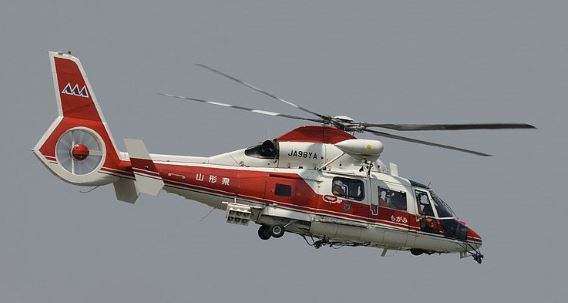 Retracting the undercarriage, the pilot of Yamagata’s AS365N2 increases airspeed on takeoff
Retracting the undercarriage, the pilot of Yamagata’s AS365N2 increases airspeed on takeoff
from Yamagata Airport in May 2011. This aircraft was replaced by the AW139 after
17 years’ sterling service,. (Photo: contri via Wikimedia Commons)
 Whereas Ehime Prefecture has a reputation as one of Japan’s tangerine-growing areas, Yamagata
Whereas Ehime Prefecture has a reputation as one of Japan’s tangerine-growing areas, Yamagata
is famous for its cherries, and thus a pair adorns each side of the current Mogami. The unit’s
aircraft are traditionally named after a river that passes though all four of Yamagata’s regions.
(Photo: モツ鍋幸行[丙種] via Twitter @tobu_moha8516)
 On top of its nose, the AW139 carries a large white Yamagata Air Rescue badge of an elaborate
On top of its nose, the AW139 carries a large white Yamagata Air Rescue badge of an elaborate
winged design; this was in gold on the AS365N3 (link).
(Photo [August 2019, Tochigi Heliport]: 祥 via Twitter @rescue60k)
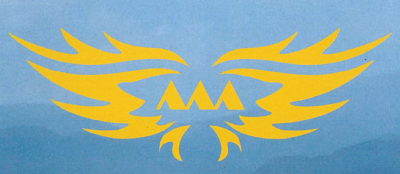 Note that the winged nose marking design incorporates the prefectural flag marking carried on
Note that the winged nose marking design incorporates the prefectural flag marking carried on
the tail (see below). (Image from Yamagata Air Rescue publicity brochure)
 (Image from Yamagata Air Rescue publicity brochure)
(Image from Yamagata Air Rescue publicity brochure)
On the side of the fuselage is another Yamagata Air Rescue badge (above), a shield depicting two thistle-like safflowers, the prefectural flower, above the words SINCE 1998. A version of this was also carried in miniature on the rear cabin doors of the AS365N3 (link).
J-HangarSpace had to elicit the help of an official within the Yamagata Prefecture disaster prevention organization to ascertain the significance of the large mysterious square marking on both sides of the aircraft’s rear fuselage. It turns out that Mogami also serves as a flying billboard, as the marking is the brand logo for Tsuyahime, a variety of organic rice cultivated in designated areas in the prefecture. (Adding the name might increase the marking’s effectiveness for those unfamiliar with agricultural products!)
The form of the marking is that of a colorful “rice symbol” reference mark ※ that in Japanese serves the same function as an asterisk.
 (Photo [June 2020, Yamagata Airport]: KOHYA via Twitter @kij_photo)
(Photo [June 2020, Yamagata Airport]: KOHYA via Twitter @kij_photo)
As yamagata literally translates as mountain-shaped and can also mean a chevron, the prefectural flag marking is of a row of three snow-covered peaks on a light blue background. These serve to denote Dewa Sanzan, the three sacred mountains (Mts. Gassan, Haguro and Yudono) of the ancient province of Dewa (modern-day Yamagata) and the Mogami River. As both aircraft have sported cherry red colour schemes, the mountain emblem tail marking has been blue edged in white.
 Training at Yamagata Airport, March 2018 (Photo: Cp9asngf via Wikimedia Commons)
Training at Yamagata Airport, March 2018 (Photo: Cp9asngf via Wikimedia Commons)
| Yamaguchi Prefectural Disaster Prevention Aviation Unit | ||||
| Operator | Asahi Helicopter Co., Ltd. | |||
| Base | Yamaguchi-Ube Airport | |||
| Date Formed | Jan. 1, 2000 | |||
| Helicopter Type | Reg’n | c/n | Name |
First Deployment Date |
| BK117C-1 | JA21YA | 1124 | Kirara | May 1, 2000* |
| AW169 | JA35AR | 69080 | Kirara | May 2019 |
| * Aircraft first registered Feb. 2000 Note: On Aug. 2, 2017, Mitsui Bussan announced order for an AW169 for spring 2019 delivery |
||||
| Last updated: Sept. 18, 2021 | ||||
 (Photo [June 2018]: れんし via Twitter @Kirara21YA)
(Photo [June 2018]: れんし via Twitter @Kirara21YA)
 Both Kirara in front of the unit’s hangar at Yamaguchi-Ube Airport in August 2019.
Both Kirara in front of the unit’s hangar at Yamaguchi-Ube Airport in August 2019.
(Photo: れんし via Twitter @Kirara21YA)
 (Photo [Dec. 2020]: れんし via Twitter @Kirara21YA)
(Photo [Dec. 2020]: れんし via Twitter @Kirara21YA)
| Yamanashi Prefectural Disaster Prevention Aviation Unit | ||||
| Operator | Japan Aviation Academy Network (JANET) Corporation | |||
| Base | Japan Aviation Academy, Futaba Heliport | |||
| Date Formed | Apr. 26, 1995 | |||
| Helicopter Type | Reg’n | c/n | Name |
First Deployment Date |
| S-76B | JA6748 (link) | 760429 | Akafuji | Apr. 26, 1995* |
| S-76D | JA223Y | 761077 | Akafuji | Apr. 2018 |
| * Aircraft first registered Jan. 1995 | ||||
| Last updated: Sept. 16, 2021 | ||||
 Devoid of any prefectural flag markings, the Yamanashi aircraft’s only departure from what
Devoid of any prefectural flag markings, the Yamanashi aircraft’s only departure from what
appears to be essentially a corporate colour scheme is the Mt. Fuji design and its
Akafuji (Red Fuji) name incorporated into the cheat lines.
(Photo [Chofu Airport, Tokyo, Jan. 2020]: Wilco via Twitter @Wilco11886715)


